By Rick VanSickle
It was sudden and swift; a tiny window of opportunity on Oct. 14, 2021, to grab as much Riesling off Field D in the St. Urban Vineyard as was humanly possible before any more dreaded rain fell the following day.
The text from Vineland Estate winemaker Brian Schmidt was short and sweet: “The grapes for your #RickWine2.0 are coming off … NOW … they are having to clean each bunch by hand.” I don’t remember where I was or what I was doing, but I simply jumped in my car and bolted to Vineland
Estate in that moment.
Note: Ontario wine vintage charts back to 1998, including an early assessment of 2021, will be published on Wines In Niagara on Friday.
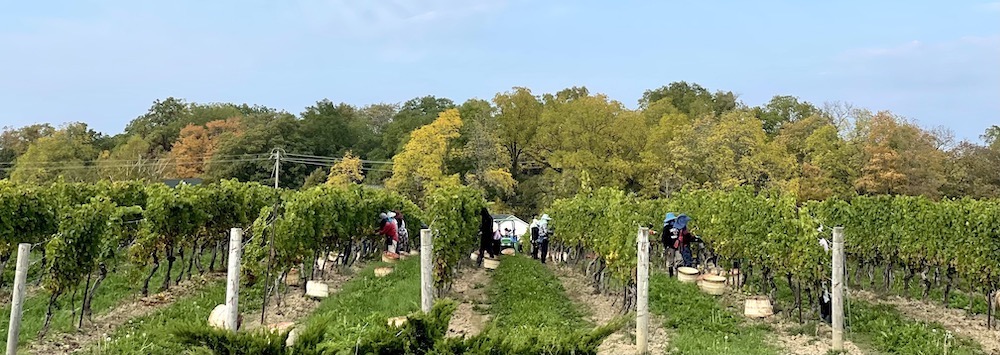
By the time I got there, Schmidt had secured an emergency grape-picking crew that numbered in the dozens. They were going up and down the five or so rows of grapes earmarked for a special Riesling project I was a part of. They were feverishly cutting off compromised bunches of grapes that just weren’t going to make it into the final cut. If memory serves, the skilled crew made two passes, methodically culling the crop, even cutting out individual undesirable berries, before filling empty baskets with the surviving grapes.
Schmidt fired up the tractor and assistant winemaker Tobia Fiebrandt and I hopped on the back and went up and down the rows tossing full baskets of plump Riesling grapes into the bin being pulled on the flat bed of the tractor. It went lightning fast; and no sooner than the grapes were picked, then they were on the crush pad and making their way into the press for processing.
In a lot of ways, this was the perfect metaphor for Harvest 2021. A seemingly stellar vintage was unfolding all summer long, much like 2020, until the rain came. And man, oh, man, the rain came and just never stopped.
“It all changed in an instant,” said Schmidt. “The lyrics to Green Day’s song, Wake Me Up When September Ends, played in my head for Weeks 3 and 4. September ended but the song didn’t. At harvest time, humidity in small doses is tolerable. Five days of fog and 100% humidity combined with cool temperatures? Ugg, the wheels were falling off in front of our eyes in real time.”
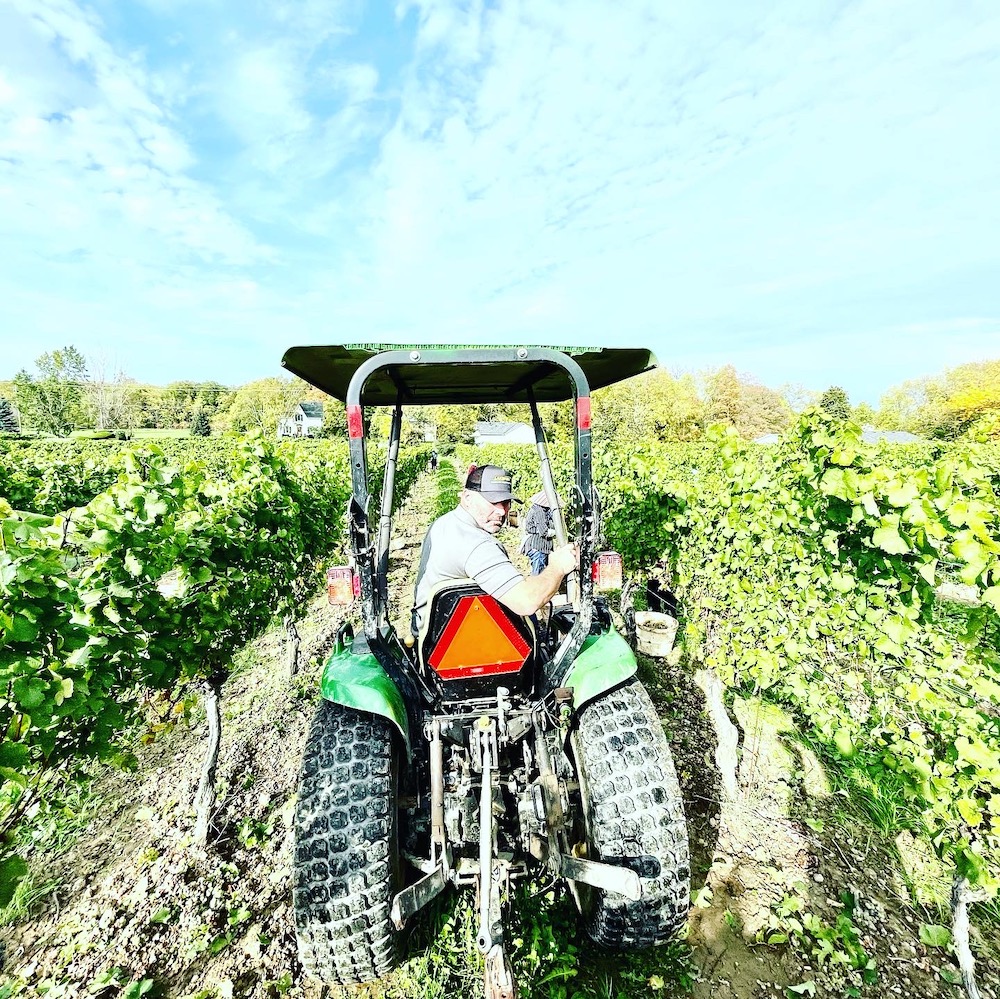
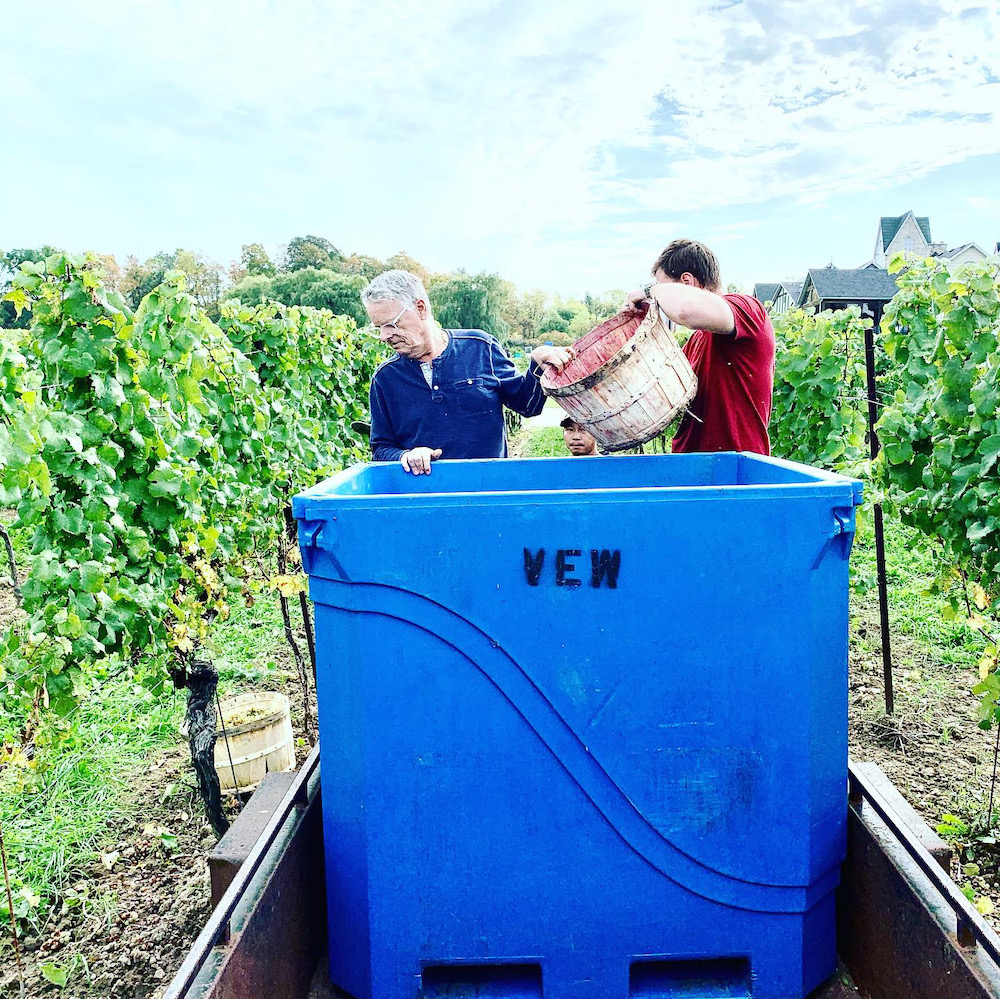
The relentless rain was causing havoc across the wine regions in Ontario. With upwards of 580 mm of rain from September to November, Hidden Bench’s Harald Thiel said, “there was quite a bit of dilution in flavours and some breakdown in the fruit.”
Malivoire winemaker Shiraz Mottiar agreed. “It was so bad, that for one week in October, there was only fog. Literally – no sun at all! All that rain kept diluting the sugars in the grapes (except Gamay) and all that humidity made it impossible to prevent rot from setting in. But we did manage to bring in tasty fruit.”
I witnessed it close up. I saw the skill and determination of winemakers and their harvest crews performing miracles in a race to save what they could in the vineyards they farmed. The season pushed the envelope on what wine growers know only too well — the vintage is made from Labour Day on; don’t let a great summer fool you. And so it was in 2021.
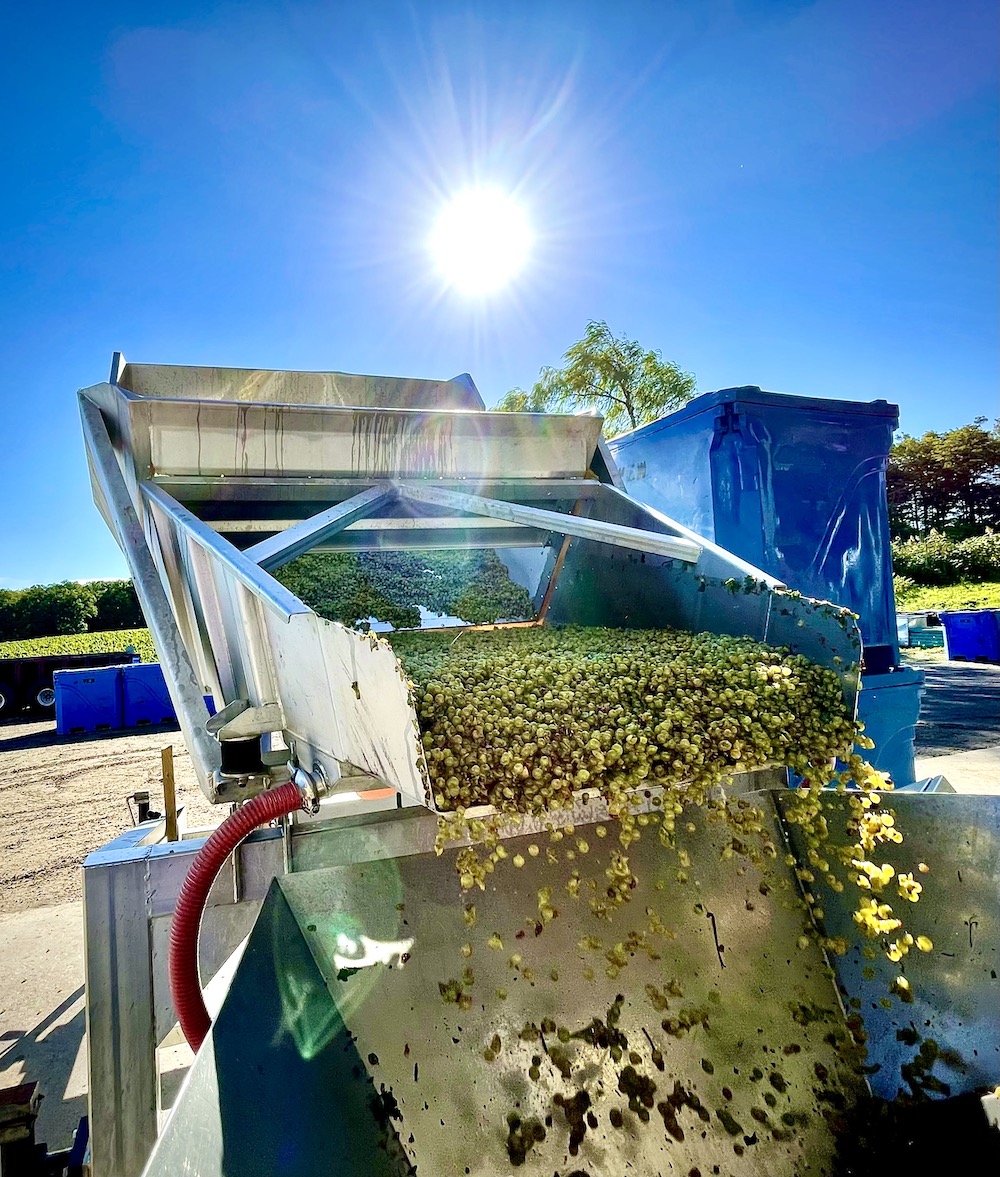
We have plenty of voices — from most of the wine regions in Ontario — to put the vintage into perspective for you. But to roundly dismiss a vintage due to tough conditions in the fall would be a mistake. 2021 was a vintage that took the utmost skill to deal with what Mother Nature delivered.
Many winemakers predict there will be successes. Riesling that was picked early enough will be “stunning,” one winemaker said. The Chardonnays will be “racy and vibrant,” and the Cabernet Francs are “standing proud, a reflection of well-honed cellaring and aging strategies.” And other early ripening grapes, such as Pinot Gris, Sauvignon Blanc, Gamay and Pinot Noir are all showing “good aromatic intensity, balance and freshness at moderate alcohol levels.” And, of course, there will be plenty of really, really great rosé!
“If there’s ever a year the wine will tell the tale of the vintage this is definitely it,” said Peller winemaker Craig McDonald, “and one winemakers will either earn their stripes or chose another career!”
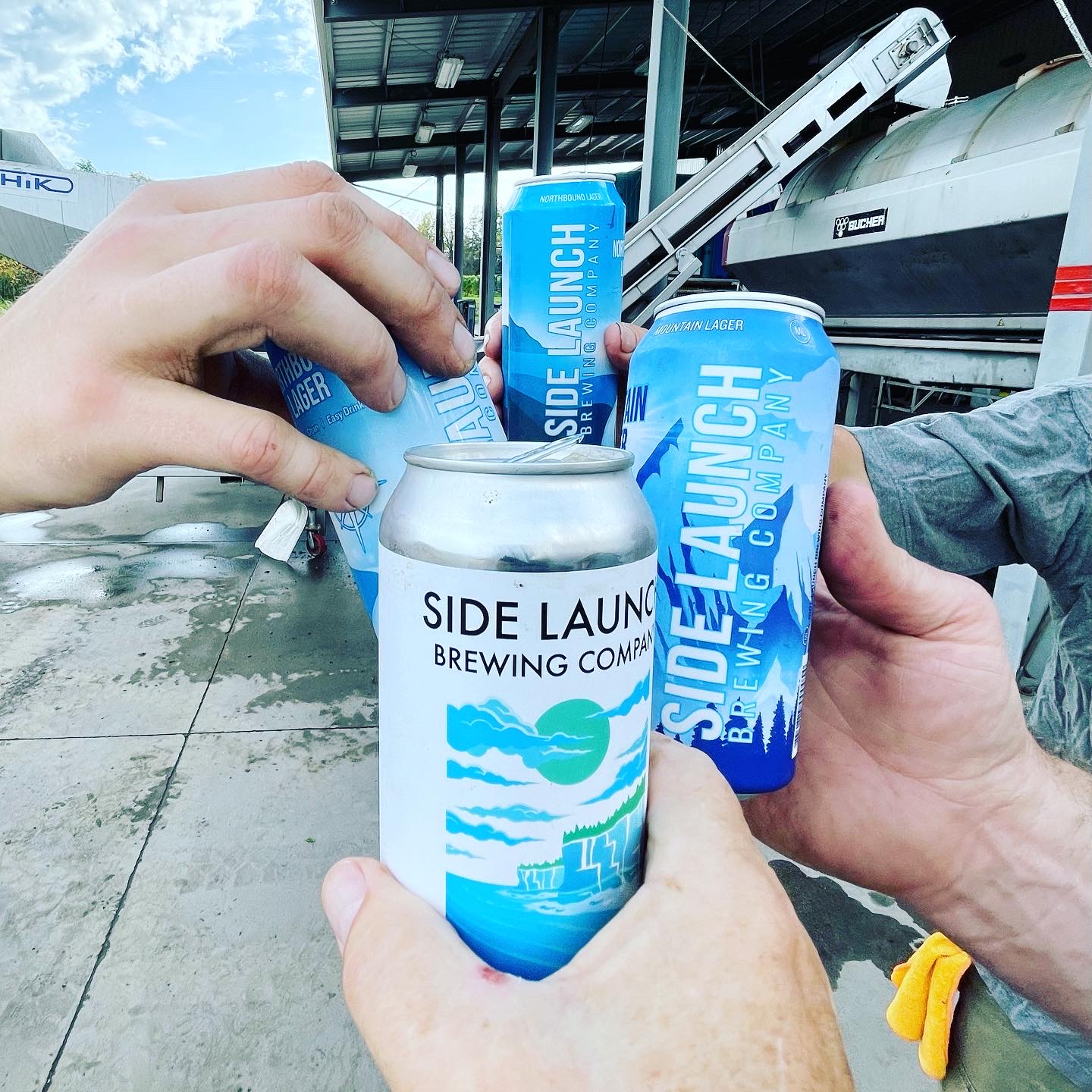
The official report from VQA Ontario called 2021 an “unforgettable year. Unpredictable weather challenged even the most experienced winemakers and grape growers,” the report says. “Record setting temperatures, intermittent drought, high rainfall and humidity – Ontario saw it all (in 2021) – led wineries to pay extra attention to vineyard management to ensure a good outcome. Fortunately, the outlook for the 2021 vintage is still positive.”
The year was defined by extreme variable weather from start to finish. By May, the weather settled into seasonal temperatures and generally dry conditions across the province – a great start to the growing season. As the summer progressed and July turned to August, the weather was dry and hot conditions prevailed. Despite scattered rain and severe thunderstorms at the end of the month, severe heat and drought were the major story by the second half of August.
Preparing for harvest in September, most were reporting good colour on red varieties, and lower acids due to the August heat, the VQA report said. After a highly variable growing season, winemakers monitored grape health and ripeness closely to plan for optimum harvest windows for each variety.
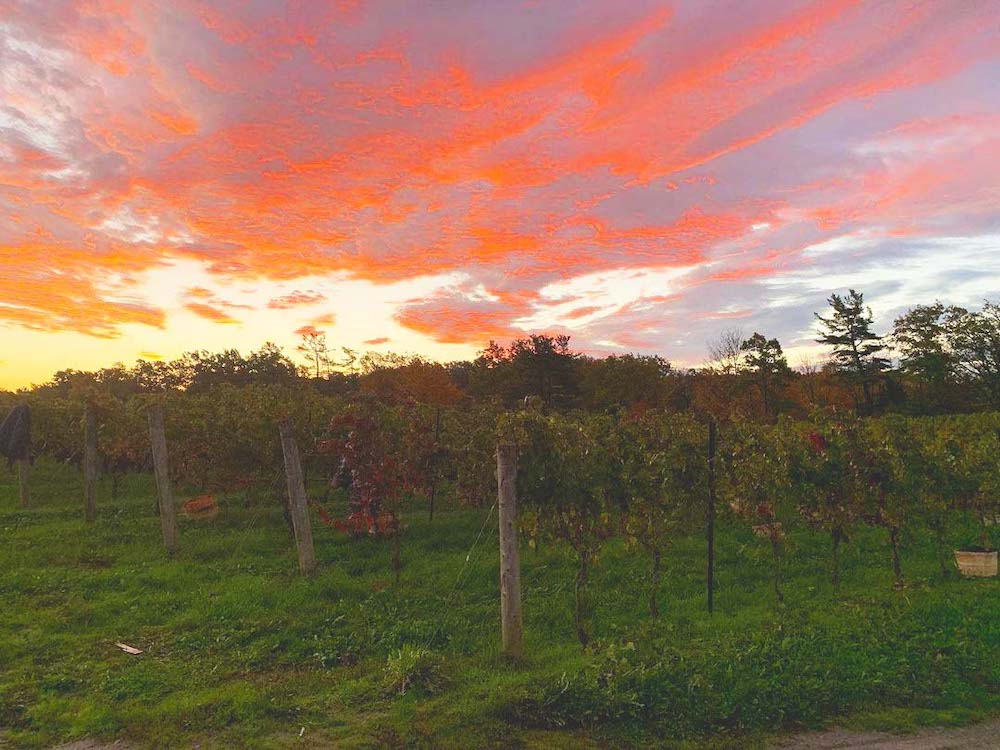
By harvest, “unstable weather continued in the fall, presenting some challenging harvest conditions. Rain and humidity at inopportune times required a strategic and nimble approach to getting grapes in at their peak in all three regions. It was a stop and start story in most regions, with bursts of precipitation slowing the harvest and introducing disease pressures to be managed.”
Early reports, according to VQA, indicate 2021 will be a good year for early white varieties that were harvested before the rains, notably aromatic whites such as Sauvignon Blanc and Riesling, and white varieties harvested for sparking programs. “Despite the weather challenges, most wineries reported good phenolic ripeness on skins and lower acid across many varieties, thanks to careful viticultural practices. Anticipate continued high quality red blends from varieties such as Cabernet Franc, Cabernet Sauvignon and Merlot.”
As for icewine, said VQA, pre-registrations for grapes set aside for the 2021 vintage totalled 1,952 tonnes, almost double the registered tonnes from last year’s record low, but still down significantly from previous years. We still don’t know if the pre-registered grapes were turned into icewine due to the breakdown of many varieties beyond the fall and into January 2022, when the first icewine harvest occurred.
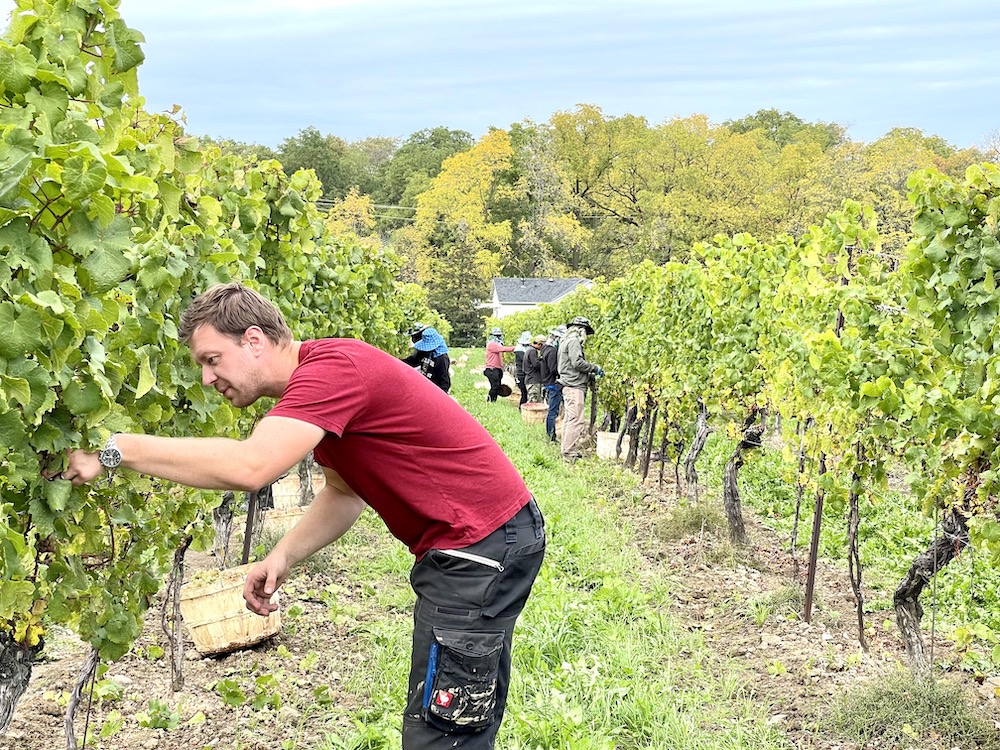
As for the little Riesling project I’m working on with Fiebrandt, yes, it will be different than originally planned, but that is the nature of the beast. We had planned for a late harvest pick for more richness and less RS with some aging in different vessels. But by the time the grapes were picked, the project moved from one field to another until the only option was fruit from Field D.
It was to be a follow-up to a similar Riesling project I took part in with Schmidt in 2012 that was documented over many posts on this website (and in a wine magazine) we called Grape Chronicles: The Journey of Grape X.
Almost 10 years later, Schmidt made me an offer I could not refuse. He asked if I was interested in another Grape X project, a reprise of sorts but with a different winemaker, a different St. Urban aspect and a different style of Riesling. Well, obviously I wasn’t going to turn that down.
Though this Riesling won’t be as originally envisioned, is was still harvested successfully on Oct. 15 at 18.6 Brix. It was fermented in stainless steel and remains on the fine lees. It sits at 10.5 abv and quite dry at 0.8 g/l. It will be bottled in 750 screw cap and is destined for Wine Club members the and wineshop under the Connections Wine Club Label.
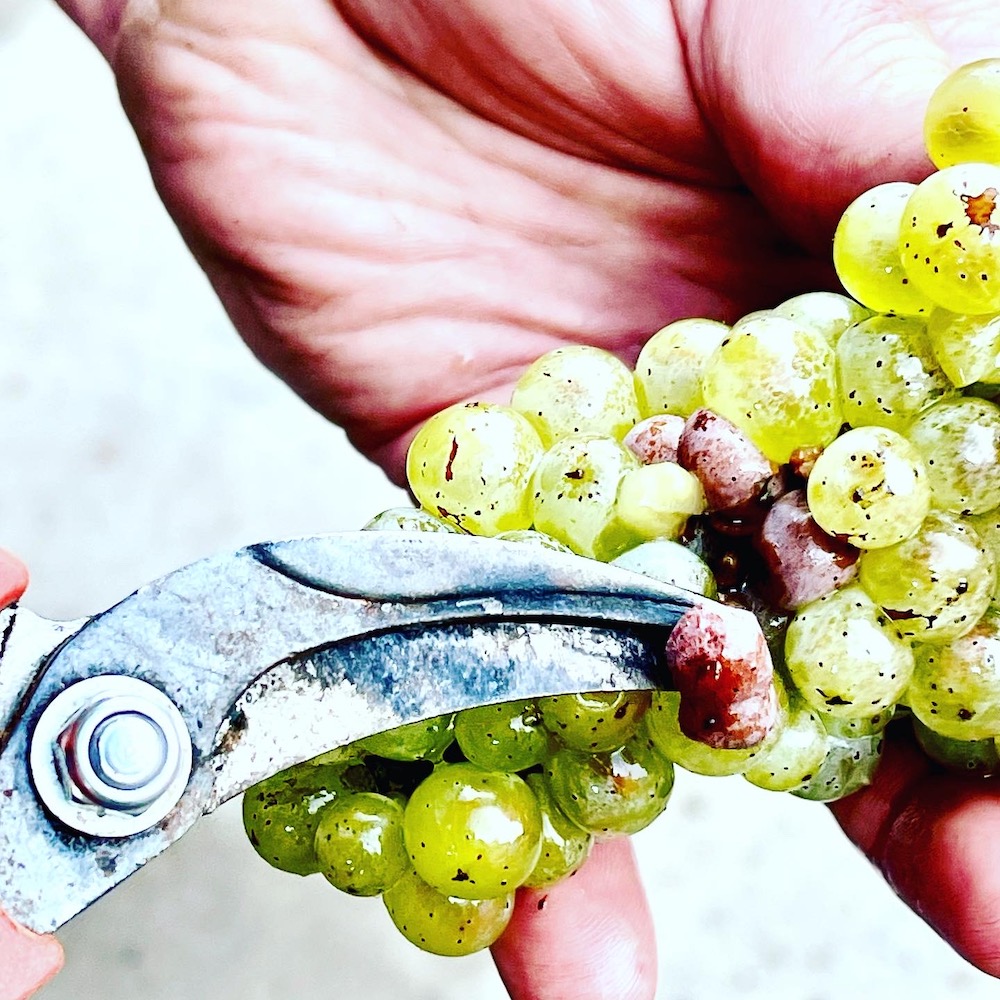
As for the style of wine with this version of Grape X 2.0, Fiebrandt wanted to differentiate it from the many other Rieslings in the portfolio at Vineland Estates. We both agreed on a drier style this time around with more lees aging, a different yeast strain to shoot for a more complex, less forward fruited and long-lived Riesling expressive of the unique minerality of St. Urban.
Really, at this point, that Schmidt and Fiebrandt even got enough grapes harvested as they did, is a miracle in itself. I’m pretty sure it will be among the most satisfying Rieslings ever made at the historic estate.
As we have done in previous years, we asked a wide variety of winemakers from across most of Ontario’s wine regions for their thoughts on the harvest. Wines In Niagara appreciates the detailed and introspective comments in the vignettes below that paint a complete, boots on the ground picture of what the vintage brought and what we can expect from the wines down the road.
Niagara Peninsula
Ann Sperling, director of winemaking and viticulture,
Southbrook Organic Vineyards, Niagara-on-the-Lake
It was a season we are glad to have behind us!
2021 was a challenging harvest due to the copious amounts of rain the entire region received in September and October, which eliminated any chance for the natural concentration in the berries that normally occurs after sugar-loading, as part of the ripening process.
Logistically, it was challenging, too, since the picking windows were often short, and we found ourselves harvesting like mad to fill the receiving area, and then processing continuously (night and day) until the fruit was safely in vat.
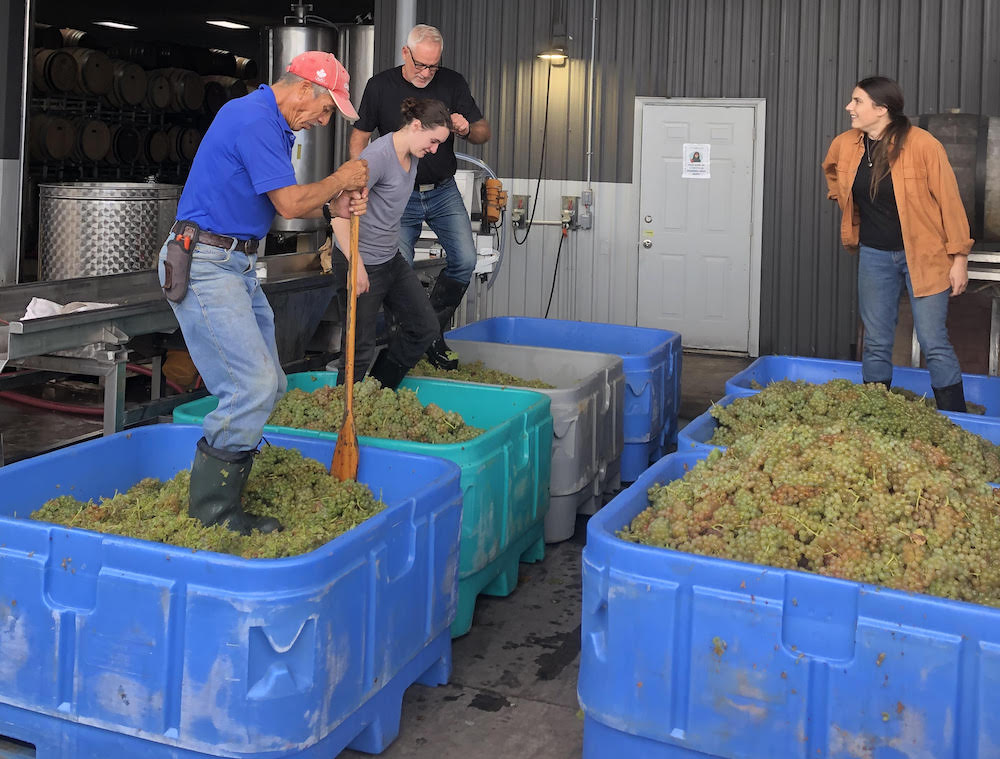
Organic and biodynamic grapes did decidedly better in 2021, having thicker skins due to season-long stimulation of the derma, i.e., the berry’s natural defense response to sunlight, as well as pest and disease pressure, which improves the integrity of the berries. Every season, this characteristic gives us good and true flavour, colour and tannins, and in 2021 when rains threatened to cause excess hydration (and/or splitting), our vineyard didn’t experience it. The skins held their contents and didn’t allow moisture to swell the berries as much as happened in conventional vineyards.
Southbrook and our key growers, Heather Laundry and the Saunders family, did solid work during the growing season, and Mother Nature — looking at the positive aspects of the vintage — did give us an early spring, and many long sunny days to develop the canopy and drive the crop consistently to the final ripening stages. The wines went smoothly through fermentation, demonstrating good nutritional status, as well as proper structure resulting in ideal TA: pH ratios with classic, ripe characteristics and no greenness. We expect that long barrel aging will help yield good results.
Craig Wismer, president of Glen Elgin
Vineyard Management, Niagara
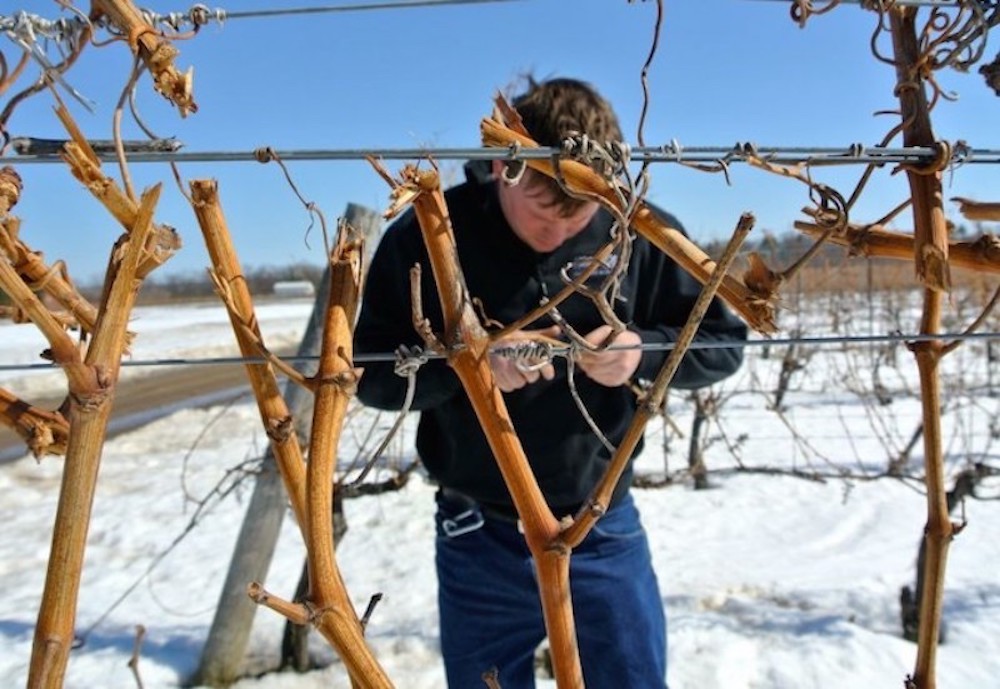
It was a challenging year, and one of extremes. This is no doubt becoming a trend in Niagara. The extreme weather and temperature swings, and how we, as viticulturists, deal with it.
Many may recall how 2020 was extremely hot and dry (making for some fantastic wines.) This drought carried over into a winter that did not see any real precipitation — snow or rain. In a true farmer’s anecdote, in the spring of 2021, we were observing some of the driest field conditions ever seen at that time of year. In the field and working in early April? Wild. Replacing wood end posts and not having the bottom three feet full of water? Bizarre.
This appreciation for an early start to work in the vineyard, quickly turned to concern. A dry spring with dry soil conditions wouldn’t bode well for a dry summer. We’ve seen drought in Niagara before, but has our typically wet spring weather (recharging the soil moisture capacity) region, ever seen a drought’s effect on already dry soil conditions?
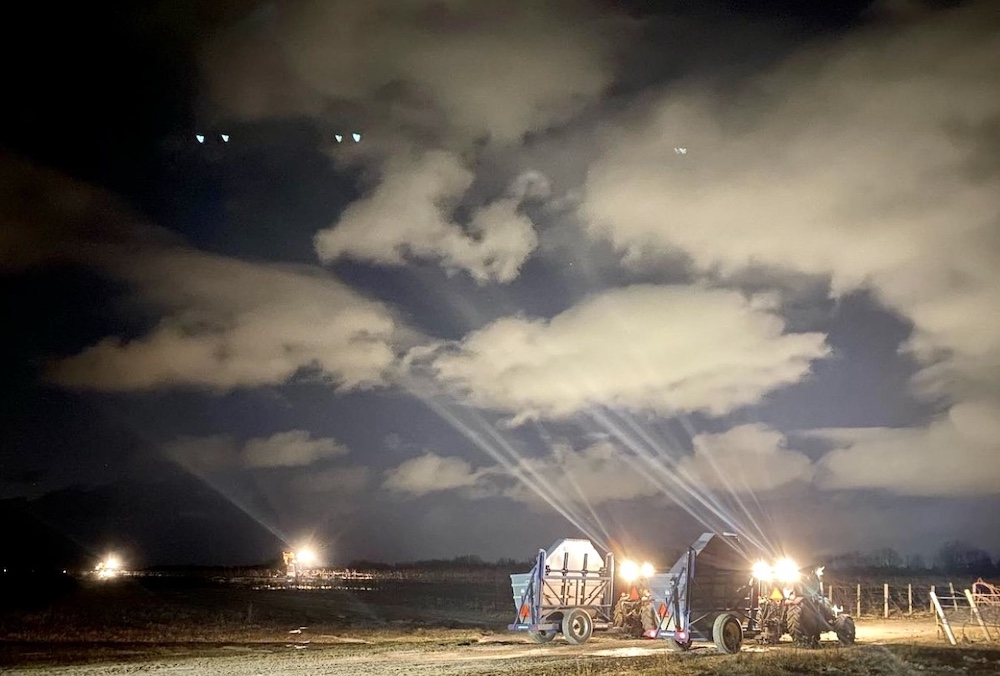
This warm, dry spring saw a slightly earlier than average bud break. As buds grew into shoots, the weather stayed hot and dry, and we saw rapid growth pushing us into an early bloom period. Bloom itself was fairly quick and consistent (ideal scenario.) Vine growth was excellent, but not excessive. This warm, dry summer weather continued, suggesting we would be looking at a very early harvest, a low yielding harvest, and likely very high quality, especially red varieties.
This theory came to a grinding halt in the third week of August. Environment Canada issued a rainfall warning — surely this is another summer thunderstorm what will never materialize? It materialized; approximately 3-4 inches of rain in one event. What was going to happen so close to harvest? How would the fruit handle the excess moisture? The fallout from this was significant; crop insurance adjusters were notified, protective sprays were applied, and we waited. Within a week, crop levels were trending up. The fruit was taking up the newfound moisture in the soil like a sponge. Some varieties ballooned to cluster weights up to 80-90% over estimates done 1-2 weeks prior.
Little did we know, that was just the beginning. The heavy and frequent rain continued throughout harvest. At one point, we had 400mm of rain in 5 weeks. The fruit, and the skins were stretched to their breaking point, and everything became a race against time. Brix and acid were generally diluted with the rains, so it became a balancing act of getting the best numbers in the field, while keeping an eye on fruit quality, and organizing logistics to get it off before the next rain. Working in conjunction with winery logistics, it was a mad dash to get as much fruit off as we could, in every window. Four harvesters running, 4-5 hand-picking crews, all working around the clock as much as possible to make it happen for our amazing customers.
It sounds like there are some great white wines in tank, along with Pinot Noir and Gamay. Time will tell for the bigger reds.
Kelly Mason, winemaker Domaine Queylus,
Honsberger and Mason Vineyard, Niagara
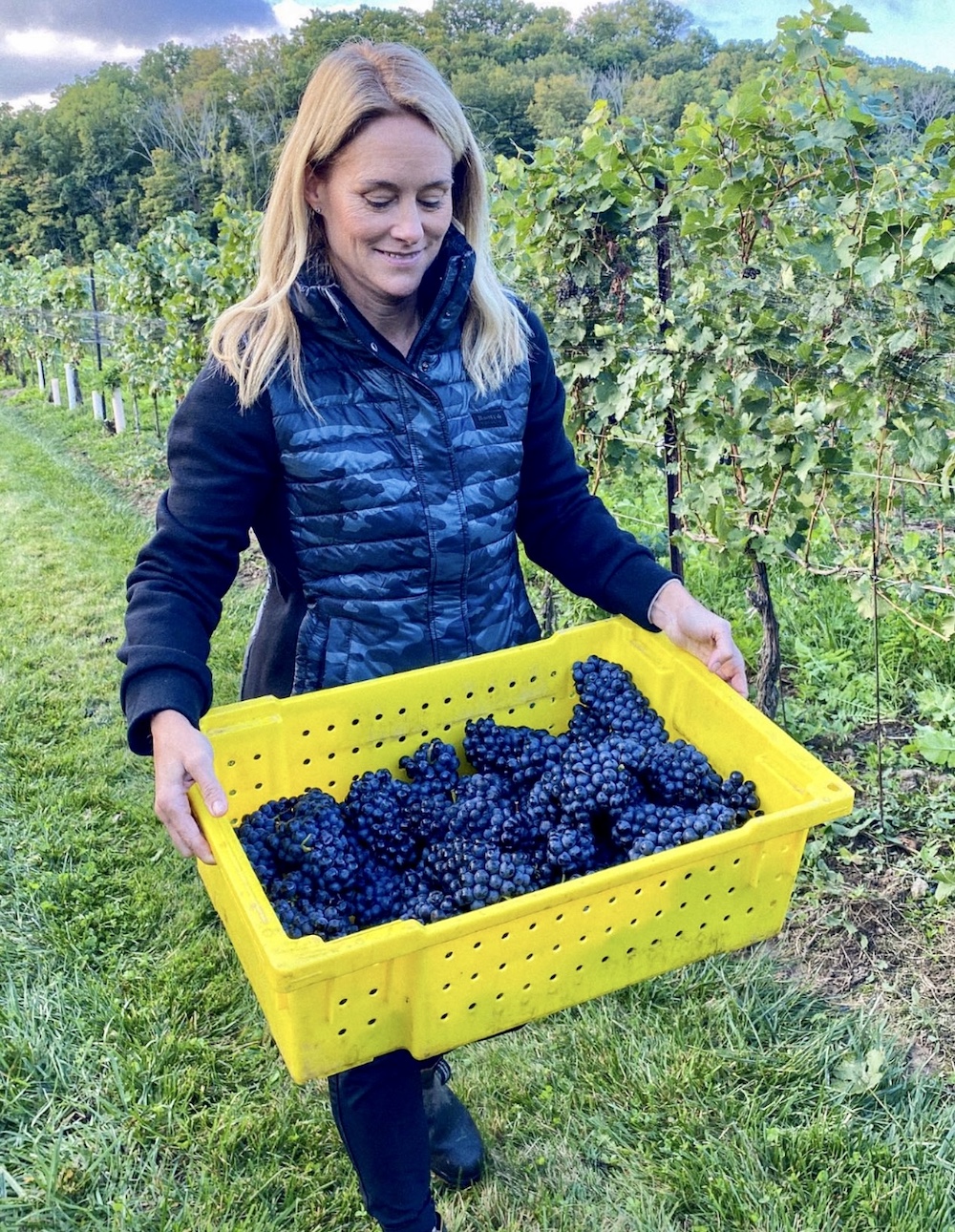
I never thought I’d say this, but in 2021, it was easier to make Pinot Noir than Cabernet Franc. The normally easy to grow and well-behaved Cabernet Franc was a challenge in 2021. Pinot on the other hand, was easier to navigate, but nonetheless it was still Pinot.
Mother Nature was relentless and kicked us even when we were down — reminding us that we are, after all, in Ontario. She added a new adrenaline rush to harvest for winemakers as we tried to react daily to weather changes.
It was often challenging to get crews to pick and seize that precious window for harvest. Tonnage was high and sorting was more important than ever. Once we got the wine in tank, the wild ferment started, stayed healthy and clean and finished quite effortlessly. We didn’t have the challenge of high sugars/alcohols of 2020. Pinot and Chardonnay were more status quo once in tank and flavours were varietally characteristic — total relief. The Bordeaux varietals were harder to ripen this year and I suspect we will see more Cabernet Franc Rosé from this vintage and possibly new entries in the sparkling category.
It’s still too soon. I don’t want to talk about it …
Adnan Icel, owner/winemaker at
Icellars Estate Winery, Niagara-on-the-Lake
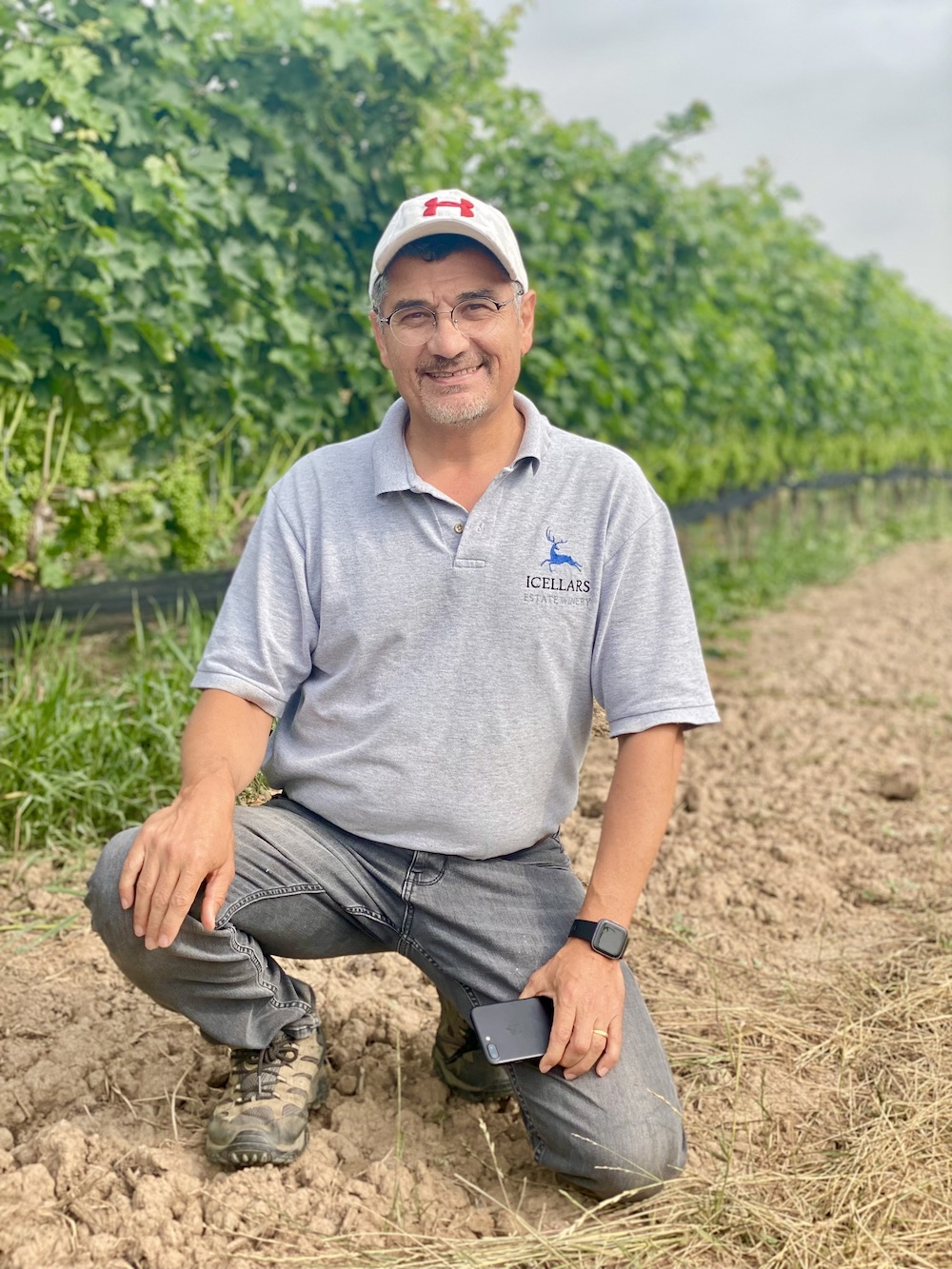
2021 was the year of many first times for us:
• First year we managed our vineyard 100% ourselves with our own staff and farming equipment from pruning to planting to spraying to weed removal to harvest;
• First year we did full organic farming working towards the certification;
• First year we applied regenerative farming. In short, RF is all about not disturbing the soil by cultivation. We used to cultivate every other row 5 to 8 times a year keeping bare soil. Instead, we kept our focus on the under-the-vine section as trying to keep there as clean as possible from the weeds;
• First year both our vineyard and winery were certified sustainable after passing a 600-question, six-hour audit after years of implementations and preparations towards these certifications.
It was a very good spring and summer weather wise until the end of August. We were thinking we were looking to an early harvest by 10-14 days.
But with the start of September, rain came, then more rain came, then much more rain came. All the 10-14 days head start was lost, and the grape maturity fell behind. Lack of heat and sun after veraison did not help on sugar accumulation and phenolics.
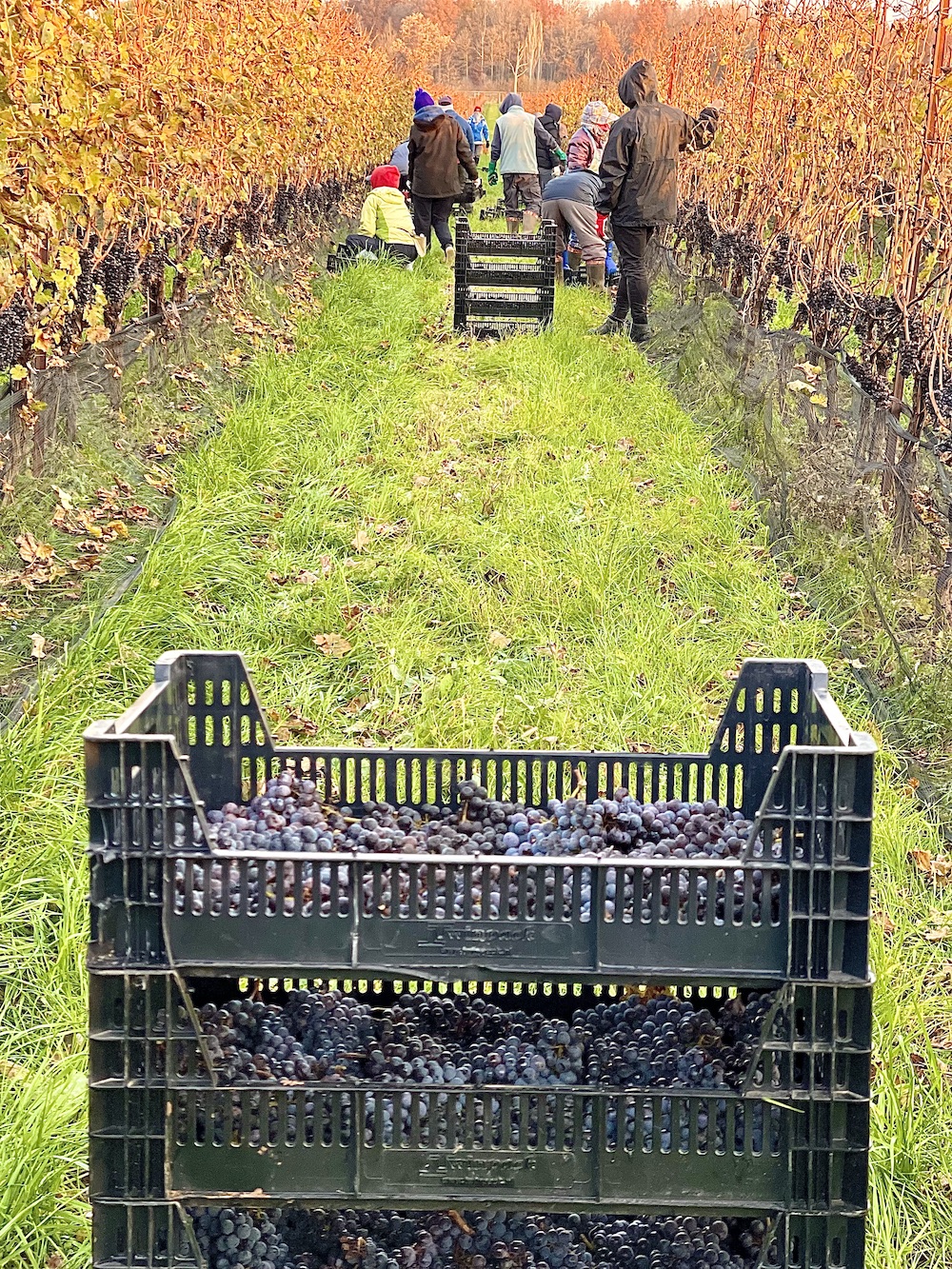
After seeing the sad conditions of some conventionally farmed vineyards struggling with mildew and rot, we felt we were lucky to implement organic farming, as a lack of chemical sprays and extra labour to open up canopy by leaf thinning and hedging helped the vines to develop a stronger self defence mechanism against heavy disease pressure. Actually, like everyone else, we thought we would be in a worse situation in such a difficult growing season by employing organic farming, fortunately we were wrong.
The grapes were picked relatively clean and disease free. But the brix levels were less than average. There were also colour deficiency issues. So, this year was the highest percentage of bleed off juice year to increase the concentration for us resulting in the largest amount of rosé making in our history.
We also made our first ever sparkling wine from our estate Cabernet Franc grapes. It is a beautiful traditional method sparkling wine now aging on lees.

If you ask me what the star grape of this vintage was, I would say Chardonnay, as we harvested excellent grapes and they turned out to be a an excellent barrel fermented Chardonnay.
We did not buy any grapes from growers as none met our very strict quality expectations. 2021 was certainly not a year to try to make as much wine as you can. We focused on our high-quality controlled yield hand harvested grapes.
Craig McDonald, vice president of winemaking,
Andrew Peller Ltd., Niagara-on-the-Lake
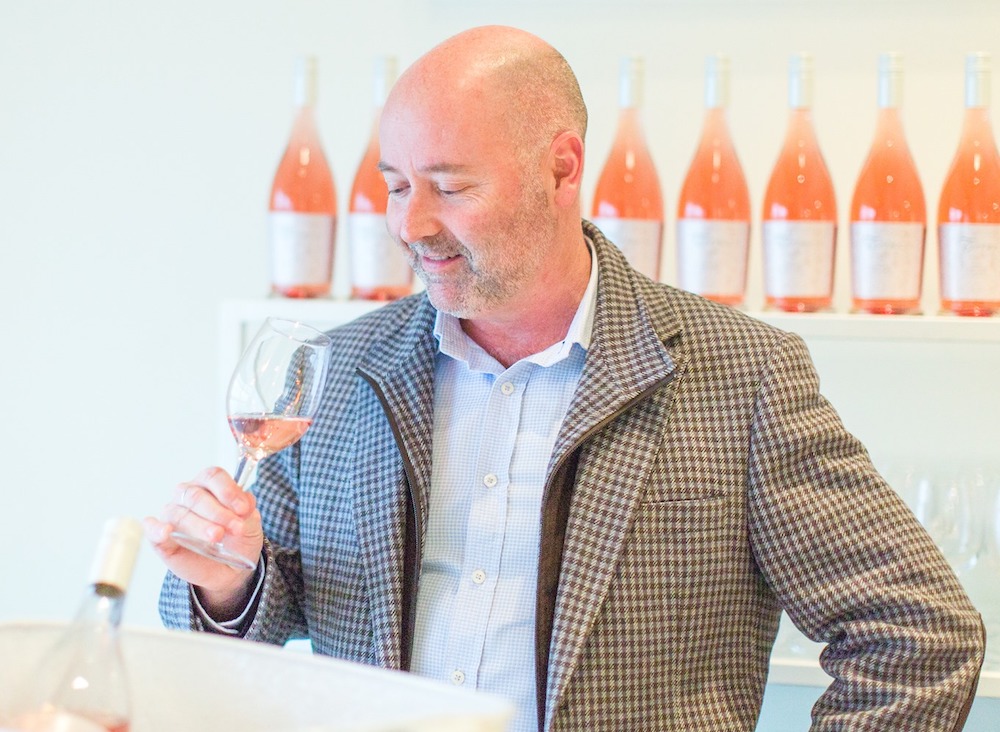
Spring was ideal and most vineyards we were at normal bud break or slightly ahead, depending on the site. The crop looked plentiful and there was a growing optimism that with a warmer summer we were in for a good crop!
June and July proved windy, rainy and slightly cooler than average and it appeared some bunch thinning was in order based on the higher load per vine.
All through August, the very intense and dry conditions persisted, and it proved to be one of the hottest on record. The excitement was building as we sailed through August with very little pressure, and it looked like we were racing through veraison for reds as we turned into September — always a good sign!
Then September, one of the wettest on record with anywhere between 200 and 500mm of rain and well above the 100mm average. It was relentless, with vineyards remaining soaked for most of the month.
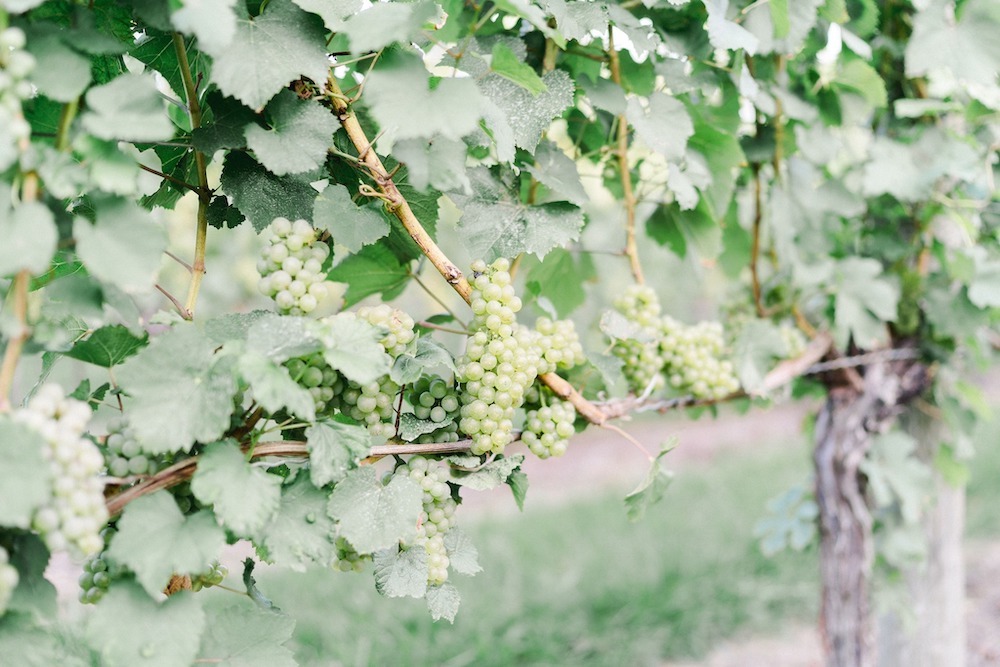
Despite sparkling and aromatic blocks coming in heavy, quality was very good with nice acidity and slightly lower sugar. One thing I’ve learned over the years was this wasn’t a season to wait, so we pushed hard to pick as much as we could when vineyards hit minimum VQA thresholds. This proved to be the right move as disease pressure mounted mid-season. Keeping ahead of the weather (we call it “surfing the wave”) was the key to ’21 and fortunately our seasoned team at Trius was able to react appropriately and throttle up.
The 2021 mid-to-late season varieties struggled with the persistent rain and with the heavier crops sugar accumulation slowed to a crawl. Botrytis proved challenging for not only whites but also some reds, in particular Cab Franc. This has challenged structure and colour and has created a softer more approachable profile vs normal.
Bigger bunched Merlot and Syrah also proved a handful with much bigger crops and massive bunches. We pivoted to supplement our growing rosé program and they made quite delicious additions to the rosé base of Pinot Noir and Gamay.
If I had to summarize the harvest, it was one of constantly inspecting vineyards, managing logistics and coordinating an ever-changing pick plan! You really had to be out there with literally mud on your boots, and I spent the better part of three weeks in October in vineyards trying to stay ahead of breakdown. In the end I feel Niagara winemakers are well equipped to deal with such years as we always expect the unexpected, but this one took it to the next level. If there’s ever a year the wine will tell the tale of the vintage this is definitely it, and one winemakers will either earn their stripes or chose another career!
Amelie Boury, vice-president of winemaking, vineyards and operations,
Chateau des Charmes Wines, Niagara-on-the-Lake
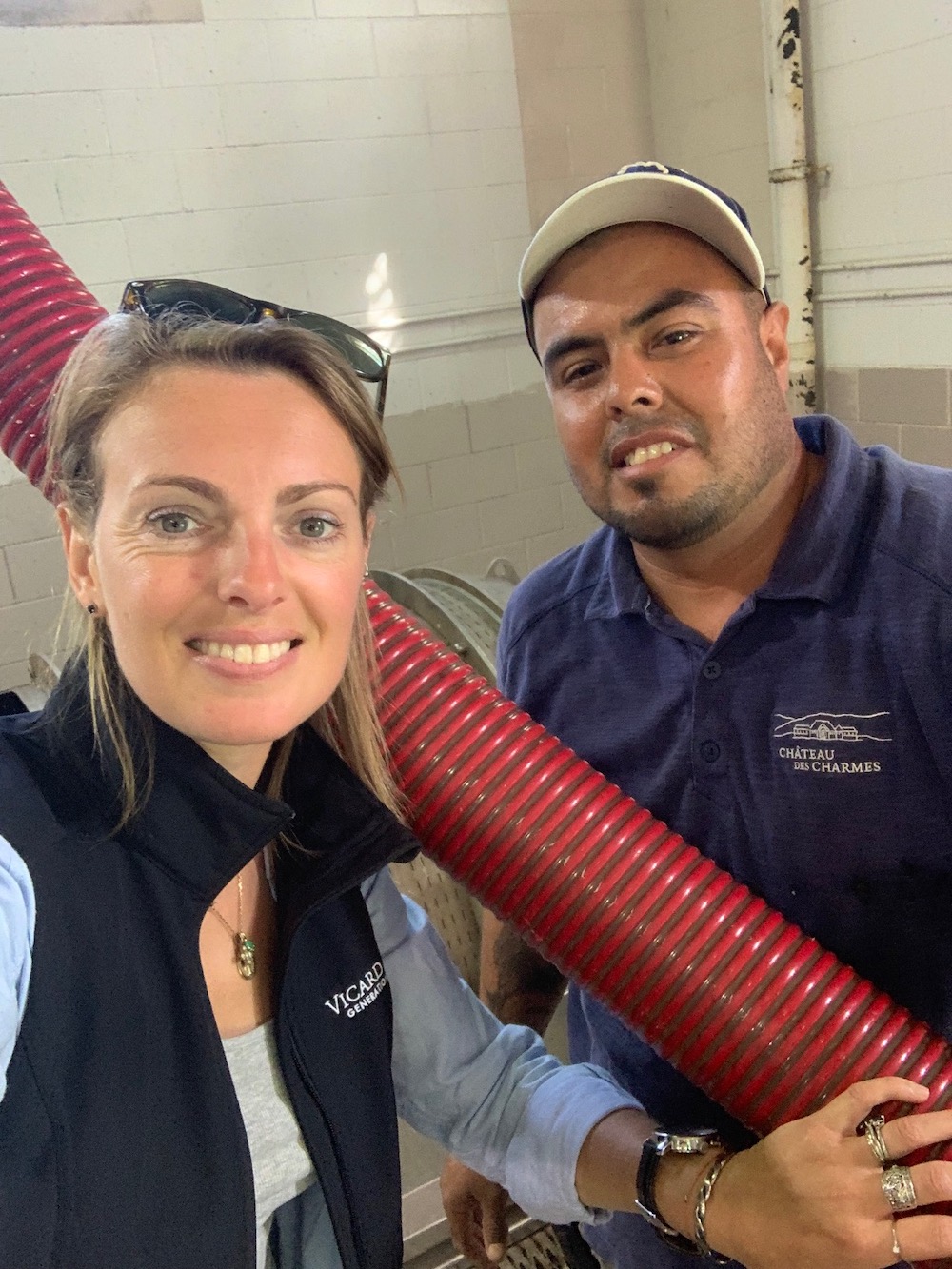
What a year. I guess this is what everyone always forgets in our industry, it is agriculture. Farming is no easy task, and this year was proof of it! Dealing with Mother Nature brings best rewards some years and countless nights of worry for some others.
This year seemed promising to us until end of July; our growing season had gone without a hiccup, the vineyard looked great, and the crew was on top of all tasks at the right time. Even biting the occasional oidium here and there.
Unfortunately, past our annual summer break, we all returned to a wet and dreary end of summer to fall. Picking conditions were really challenging even with the best grape harvester technology available (refer to my muddy picture, below).
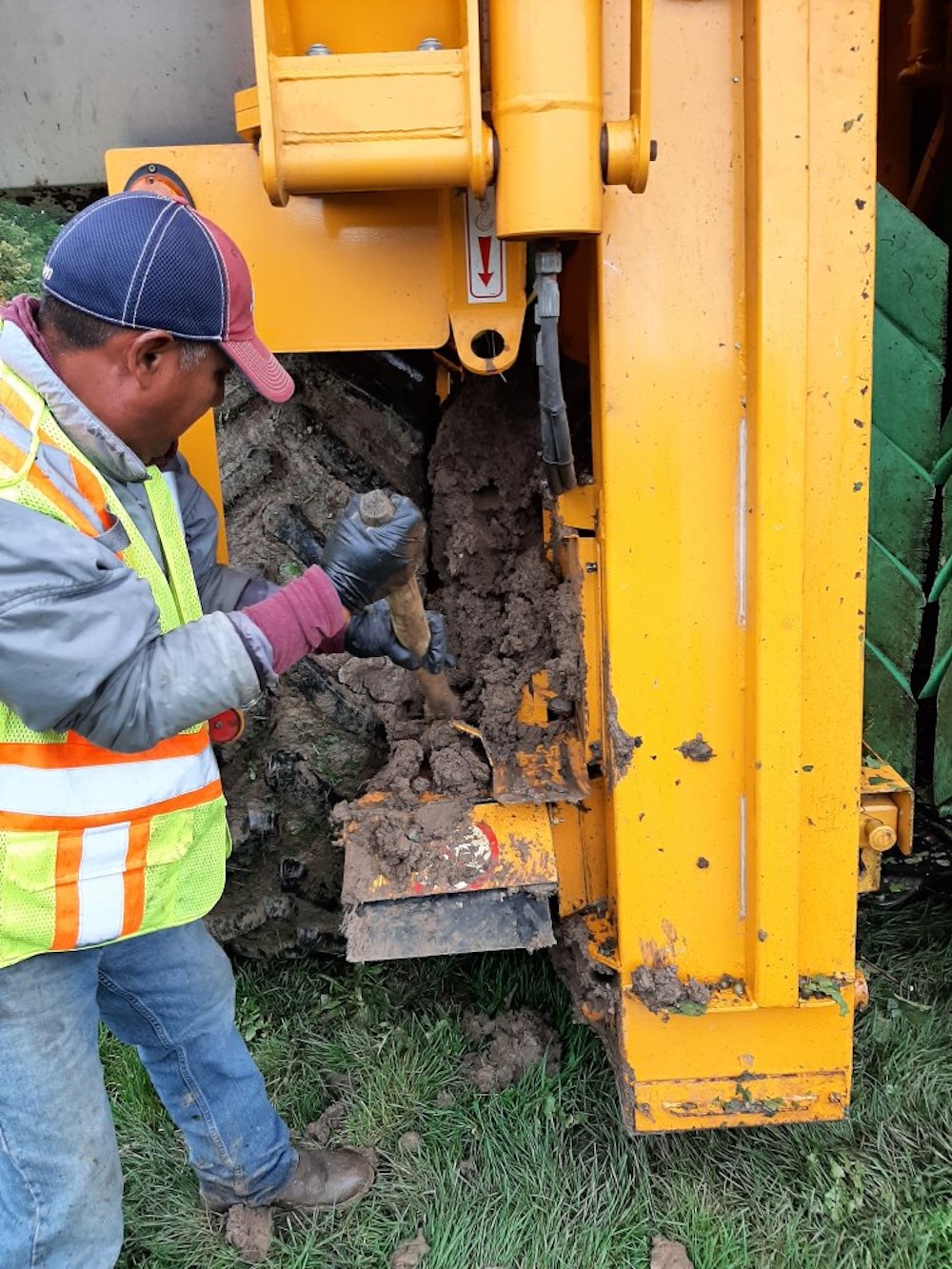
Out of all surprises, we brought in the best-looking Chardonnay I believe I ever picked in a decade, and the Pinot Noir was also a miracle.
Sadly, the story is not quite the same for our later picks of the season and the Bordeaux varietals, where much more intervention was needed from the vineyard crew to the winemaking crew.
Our first bottling of 2021 will start this spring with our Pinot Noir rosé, Gewurztraminer and SB, all a fragrant reflection of the 2021 lighter style aromatic varietals. All reds are in barrels and given all the attention needed to develop structure and mouthfeel.
To conclusw, not a vintage I would like to go back to, but definitely one that gave us a tougher skin and a lot of rethinking to do.
Brian Schmidt, winemaker at
Vineland Estates, Twenty Mile Bench
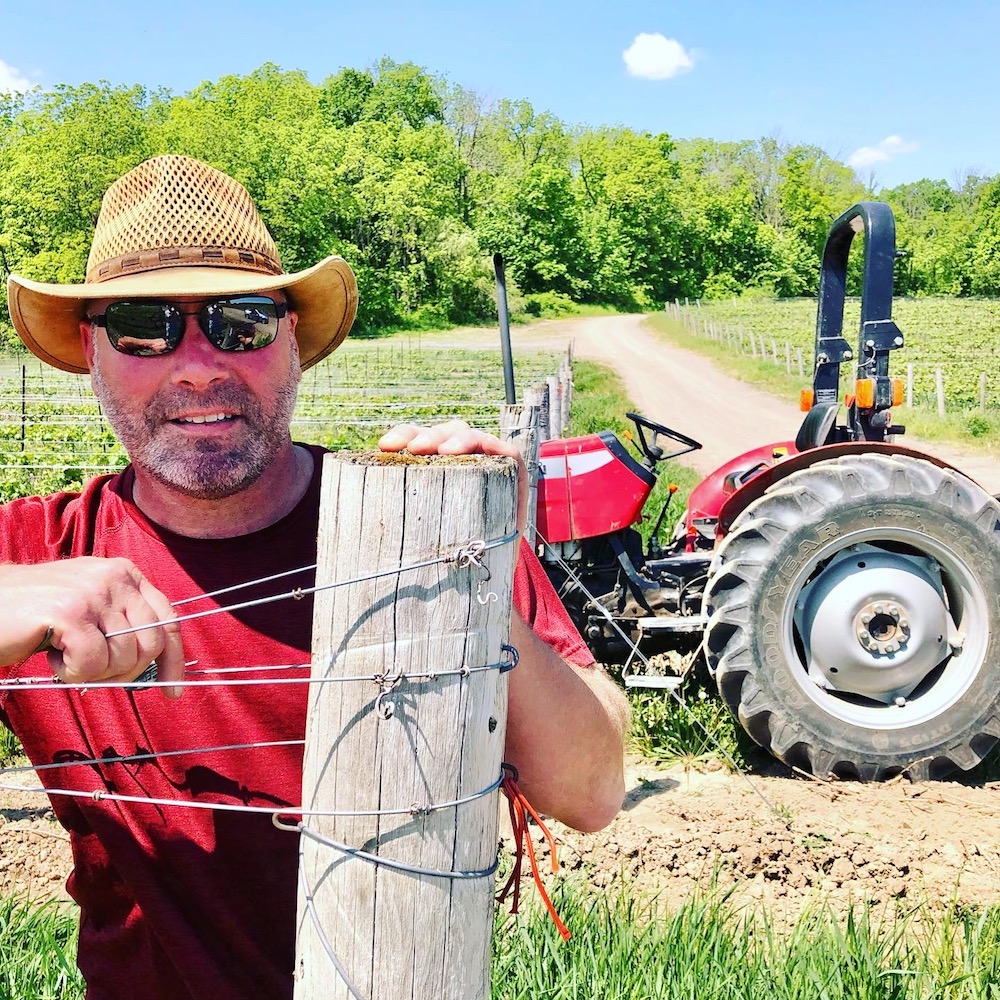
Most wine growers will tell you that the quality of a wine in a given season is mostly determined by the autumn climate. In Ontario, the 2021 vintage is probably the quintessential example of this theory.
The winter of 20-21 was mild with very little snow; this was both good and bad.
• Good: Bud survival is impacted by cold temperature, the warmer winter months resulted in low bud mortality.
• Good: The warmer winter decreased ground frost levels. This allowed the soil to warm earlier in the spring allowing the buds to emerge (or push) earlier. With early bud break we could potentially enjoy a longer growing season.
• Bad: Earlier bud break presents a risk for spring frost damage.
• Bad: with very little snow on the ground, lower than average ground water levels left little reserves for the vines to tap into as spring turned to summer.
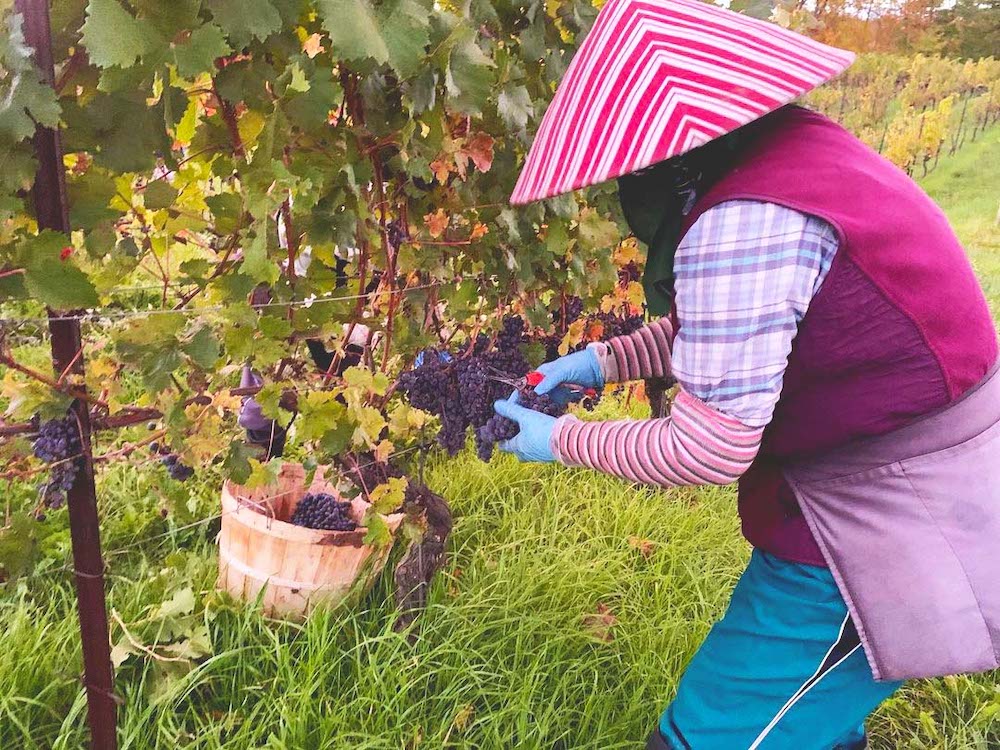
Now that we have established these points, by June 2021, wine growers had a general sense of optimism, although concerns of water level were not unfounded. In July and August, it was HOT and very dry. Those with irrigation options were delighted and they made it rain. Those without irrigation sat sweating, figuratively and literally. We did finally receive several inches of rain in mid-August. We received just enough rain to quench the thirst of young and old vines. The water was consumed almost instantly; yet there were still no water reserves.
I have heard rumours that the summer of 21 was one of the hottest on record. September, Weeks 1 and 2, I was feeling good, and we pulled many of our early ripening varieties in between the sporadic rainfalls. Then, it all changed in an instant. The lyrics to Green Day’s song. Wake Me Up When September Ends played in my head for Weeks 3 and 4. September ended but the song didn’t.
At harvest time, humidity in small doses is tolerable. Five days of fog and 100% humidity combined with cool temperatures? Ugg, the wheels were falling off in front of our eyes in real time. Ask yourself this question, what are the best conditions to grow mushrooms in? Dark and damp is your answer. A mushroom is a fungus. Mildew on vines and berries behaves much the same way as a fungus. The cool and wet conditions persisted.
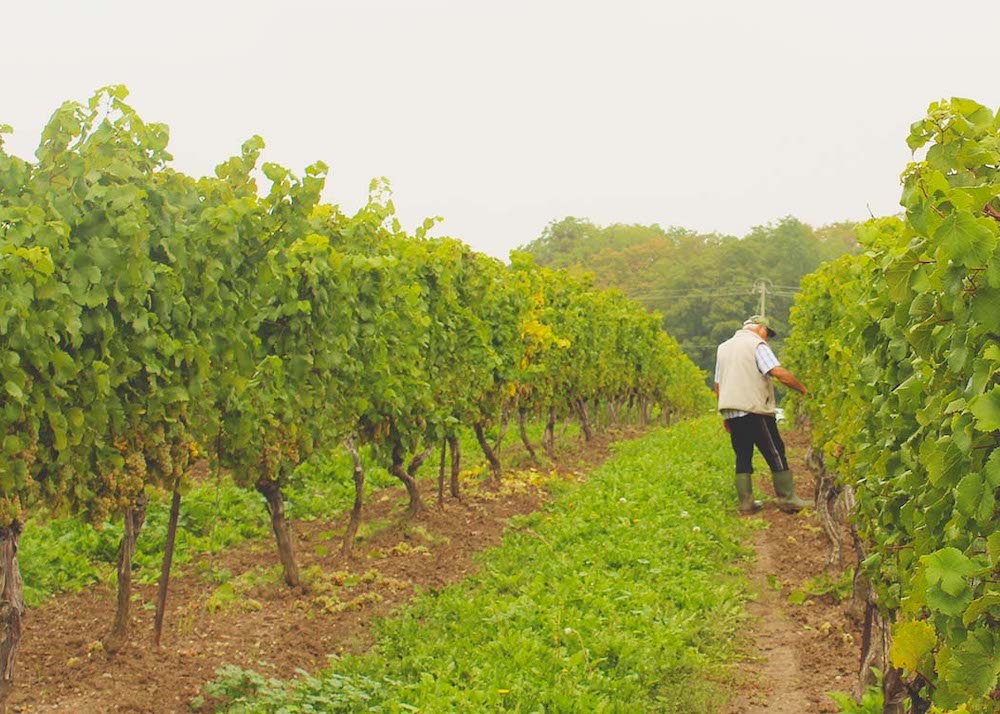
I asked our cellar crew to for their impressions of Harvest 21.
Brad said: “At times, seemingly unending and not enough single malt.”
Tobias said: “Fortune favours the bold.” He was correct, waiting was not an option. In a “normal” vintage we would sample, test, wait — sample, test wait. We would find the optimal moment to pick the fruit. For the harvest of 21 we put the coffee on, put on our rain gear and started picking grapes. Riesling, Chard, Cab Franc. It all came in with a frenzied rush and for 30 days we did not stop. Except, of course, for the moments we needed to post a picture on social media pretending that harvest was perfect.
The wines, what can you expect? Riesling: Stunning. Riesling picked early is what we do even in the best years. Chard: Racy and vibrant. I can’t wait for you to taste it. Cab Franc: Standing proud, a reflection of well-honed cellaring and aging strategies. You can expect wines with classic and approachable structure that you will want to enjoy in their youth.
Vittorio De Stefano, owner of
On Seven Estate Winery, Niagara-on-the-Lake
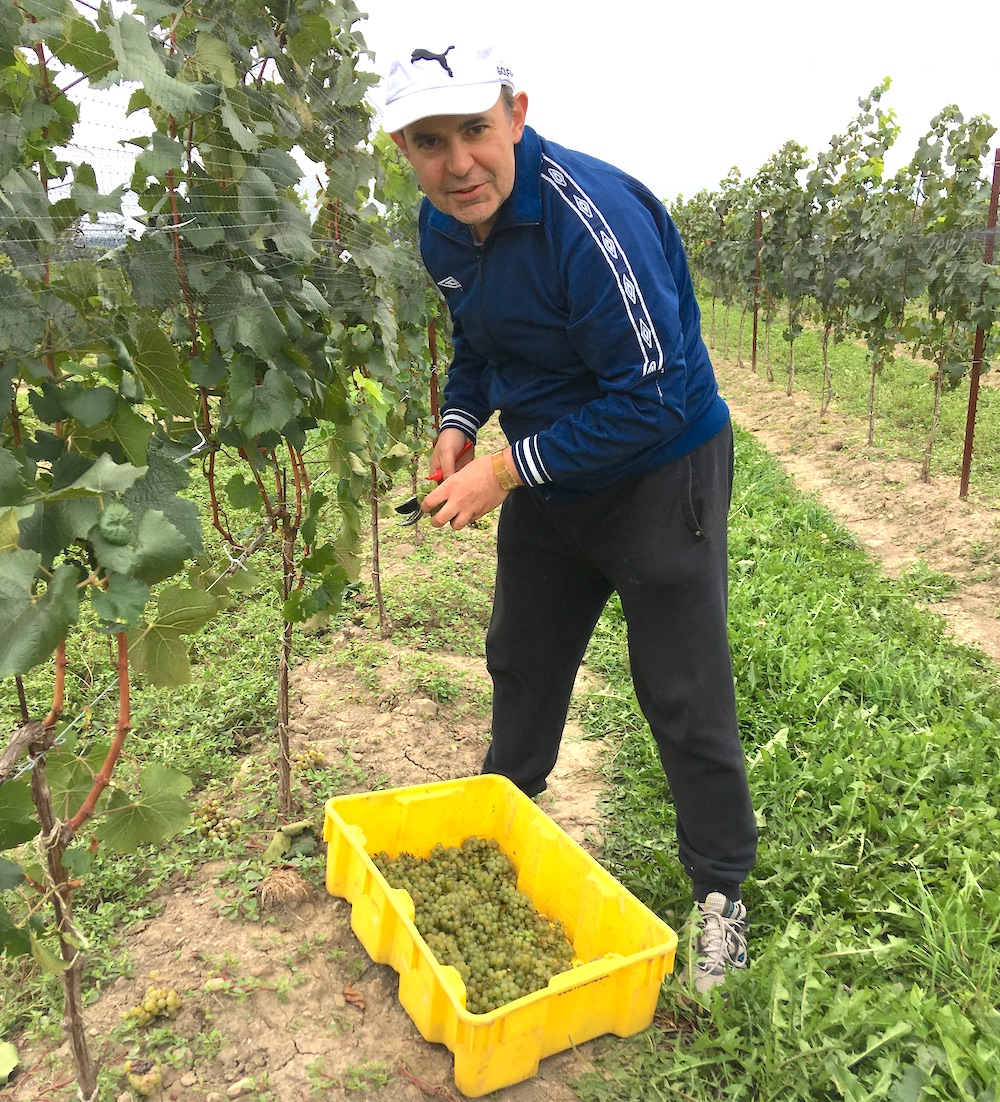
We must say that 2021 was quite the wild ride from a vineyard perspective. We started-off the season with an ideal spring, followed by a prolonged summer drought, and ended with a wetter than ‘normal’ harvest. These extremes, and the stresses they caused in the vineyard, pushed us to ‘double-down’ on tactics inspired by the traditions of organic farming.
This season, we spent significantly more time and effort than ever before in the field to maintain a healthy vineyard. To improve ripeness and concentration, we limited the crop through aggressive green harvesting. To keep disease pressures at bay, we continuously managed the canopy to encourage airflow. To harvest the healthiest and ripest grapes possible, we spent many sleepless nights monitoring fruit integrity and the weather.
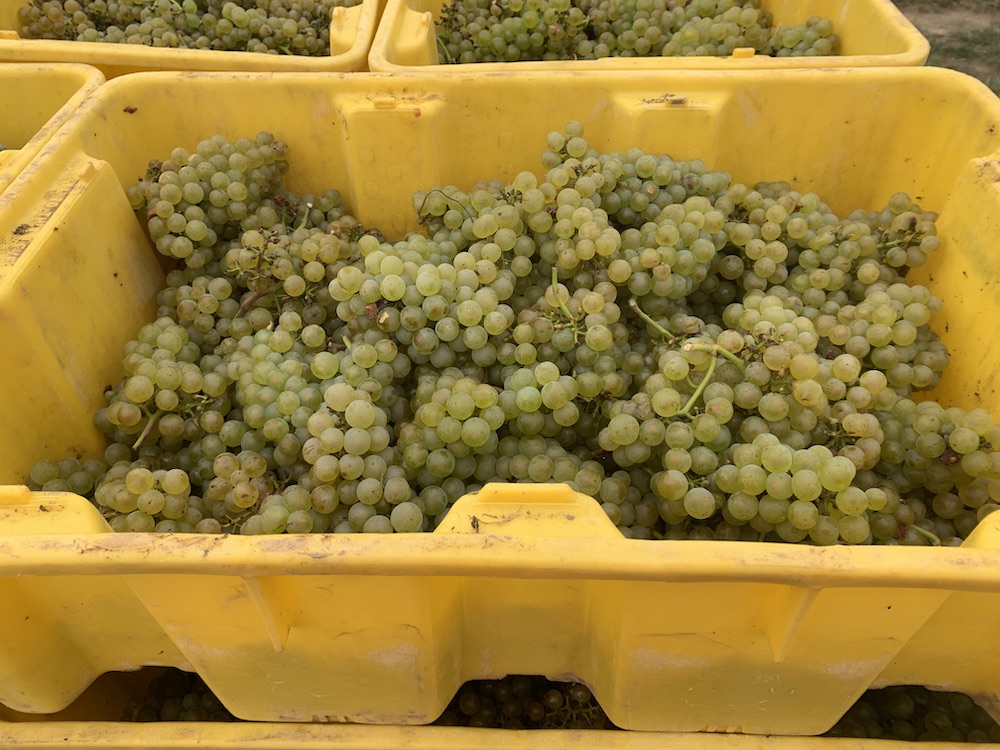
Notwithstanding all these efforts, we had to make a number of hard choices: First, we decided that On Seven will not produce Pinot Noir wine from the 2021 season. It was difficult given the continuing anticipations around the Pinot Noir wines, but this decision was essential to ensure we remained true to our quality standards.
Second, we decided that one-third of our Chardonnay (at the westerly block) was unfit for our Chardonnay wines program – given the sugar levels were 20% lower than those on the easterly block. However, a silver-lining was present in what we had initially assessed as a disastrous season. The easterly block Chardonnay that was harvested is now evolving into a delicate and elegant wine. Also, we were encouraged, maybe even allured by Mother Nature, to step outside our original offerings of wines. The Pinot Noir and westerly block Chardonnay grapes we harvested inspired us to create two new amazing On Seven wines: a Pinot Noir Rosé, and a Sparkling Chardonnay.
Dean Stoyka, winemaker at Stratus Vineyard,
Niagara-on-the-Lake

What a year 2021 turned out to be. Last time we spoke, it was end of August and we were picking Chardonnay for sparkling wine for one of our earliest picks ever. At the time, words like a “Goldilocks” year were being thrown around should the beautiful weather continue.
Alas, after September, the rest of 2021 became a challenge with respect to both weather and our patience. The advantage of such an early warm year is that most of the whites were mature and picked before any of the weather related challenges began. We are thrilled and excited for the quality of Chardonnay from 2021.
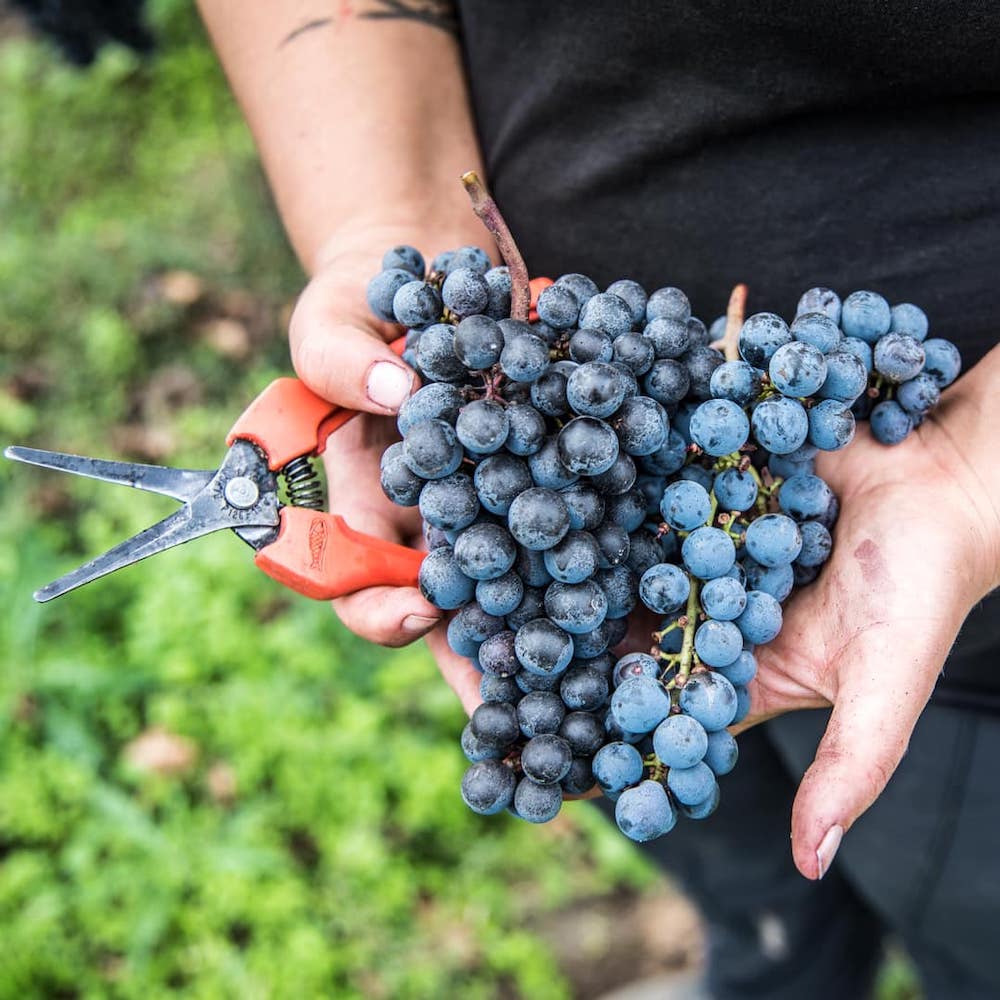
We worked very hard in the vineyard in October and November to ensure that a high quality harvest was possible. The wet October stalled maturation in the vineyard and we paused harvest until mid-November. We waited and hoped for the weather to improve in efforts to capture the beautiful flavours that developed during the first 2/3 of the year.
We finished harvest the first week of December with none other than Cabernet Sauvignon.
Patience and hard work really did pay off when the weather became drier and cooler in November. As a result, we’re excited for Gamay, Cab Franc, and Petit Verdot in particular.
Similar to 2018, we expect an exciting, complex Stratus Red when we begin blending in the years ahead.
Greg Yemen, winemaker/vineyard manager
The Organized Crime Winery, Beamsville Bench
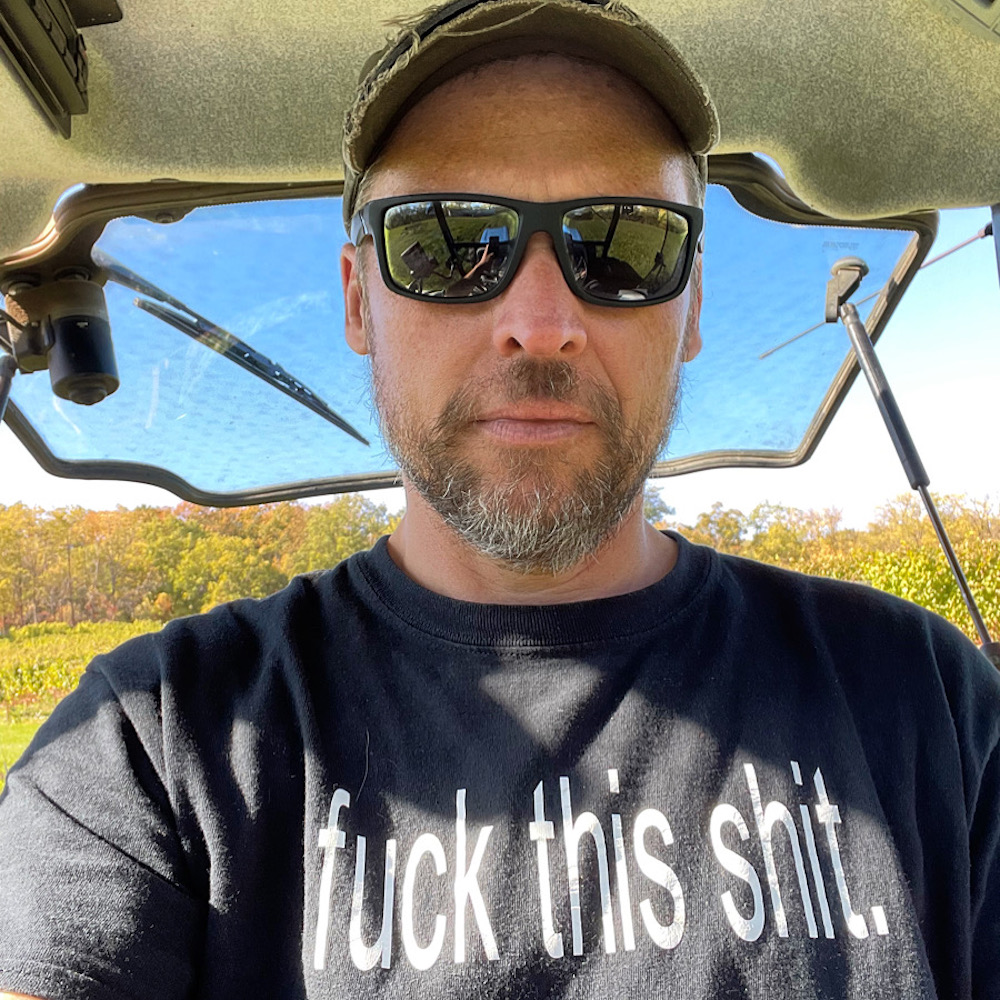
I may be a bit fuzzy on a few of the details, having spent the last two months trying to recover and forget the chaos of vintage 2021, but here we go.
After being lulled into a sense of peace and calm with the near perfect 2020 vintage, Mother Nature decided to spice things up in 2021. The growing season started off rather uneventfully with little fanfare. The hot and dry weather of July and August even led us to believe we would have an early start to harvest, and with a bit of luck, back-to-back great vintages. This was not to be. Rain started to fall in early September and by late October we had accumulated approximately 450mm at our Beamsville Bench vineyard.
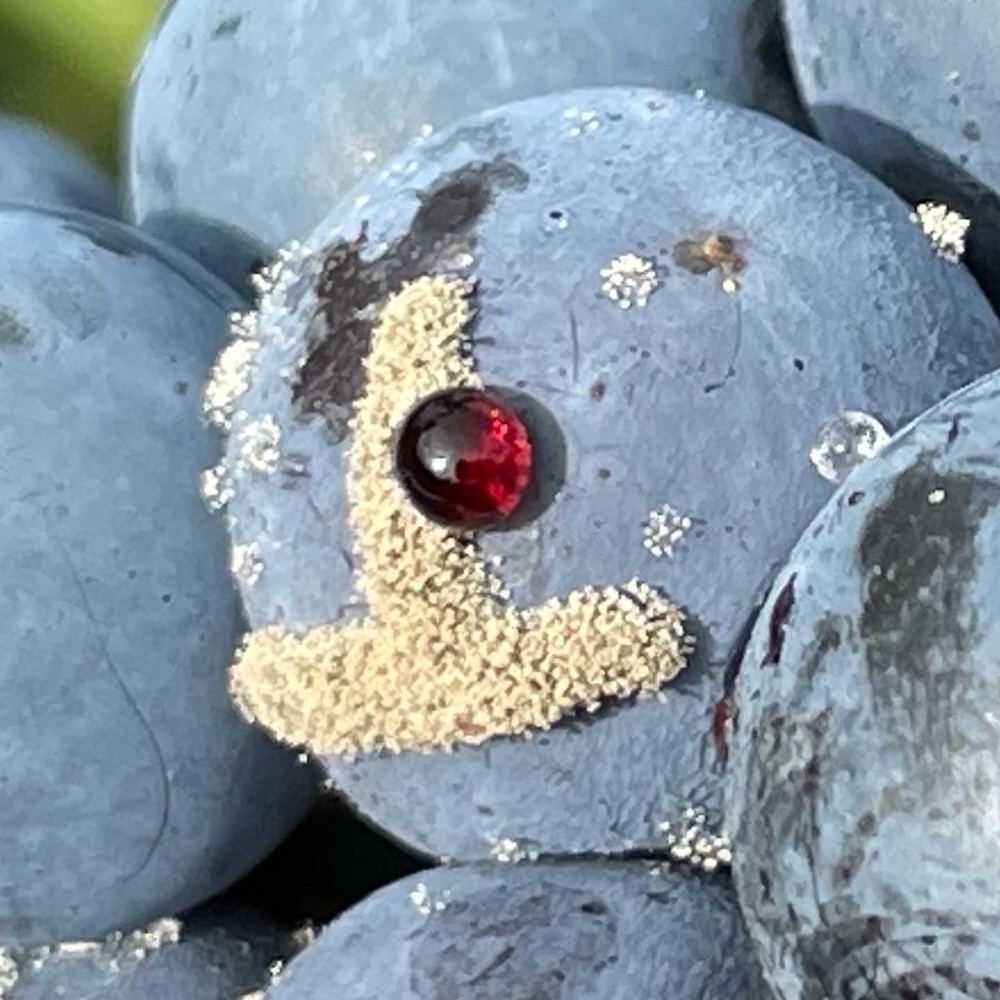
These adverse weather conditions meant we had to time our picks between the rains, fruit was hand-picked to avoid any compromised grapes, and everything was slowly and painstakingly sorted again on the crush pad.
We are fortunate to grow our own fruit and the hard work of the year paid off as we brought in all our earlier varieties clean and with good flavour ripeness at lower brix levels than usual. However, by the time we picked our Riesling in early October, the cracks were starting to show (literally). The botrytis pressure was unrelenting, the grape skins were giving up, and the forecast was painfully bleak. Most of our Bordeaux reds came in earlier than usual, being picked in late October just ahead of major rain events that threatened to finish off any grapes still hanging.
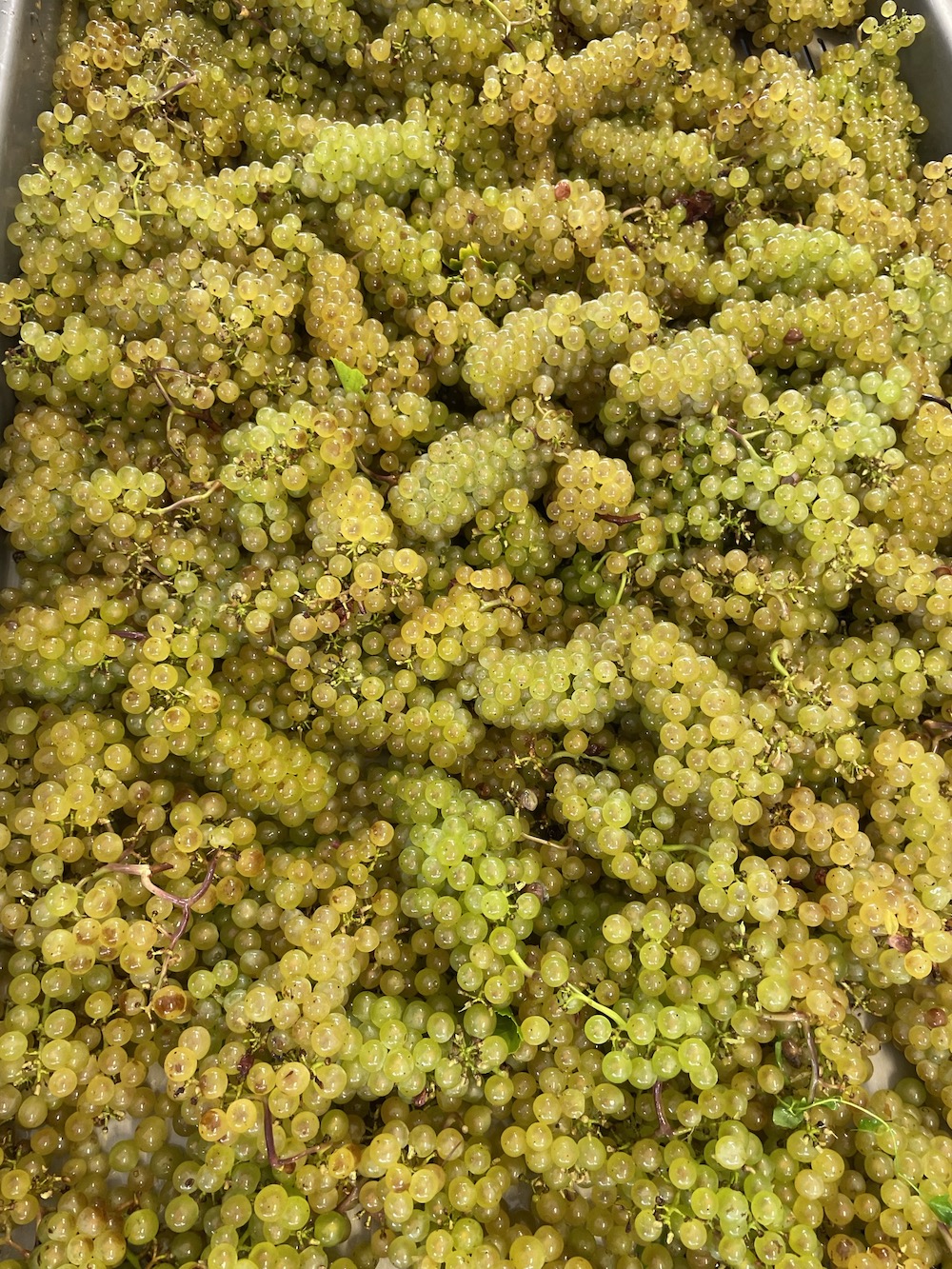
The quality of 2021 Niagara wines will be quite variable. Those who were able and willing to put in a monumental effort in the vineyard and winery will be rewarded. Our early ripening grapes, (Pinot Gris, Sauvignon Blanc, Chardonnay, Pinot Noir, Riesling) are all showing good aromatic intensity, balance and freshness at moderate alcohol levels. And while we did not produce any of our top tier of Bordeaux reds this year, gentle handling and careful extraction have given us some very fresh, fruity, drinkable reds. All things considered; I will take this as a win.
Harald Thiel, Vigneron/owner Hidden Bench
Estate Winery, Beamsville Bench
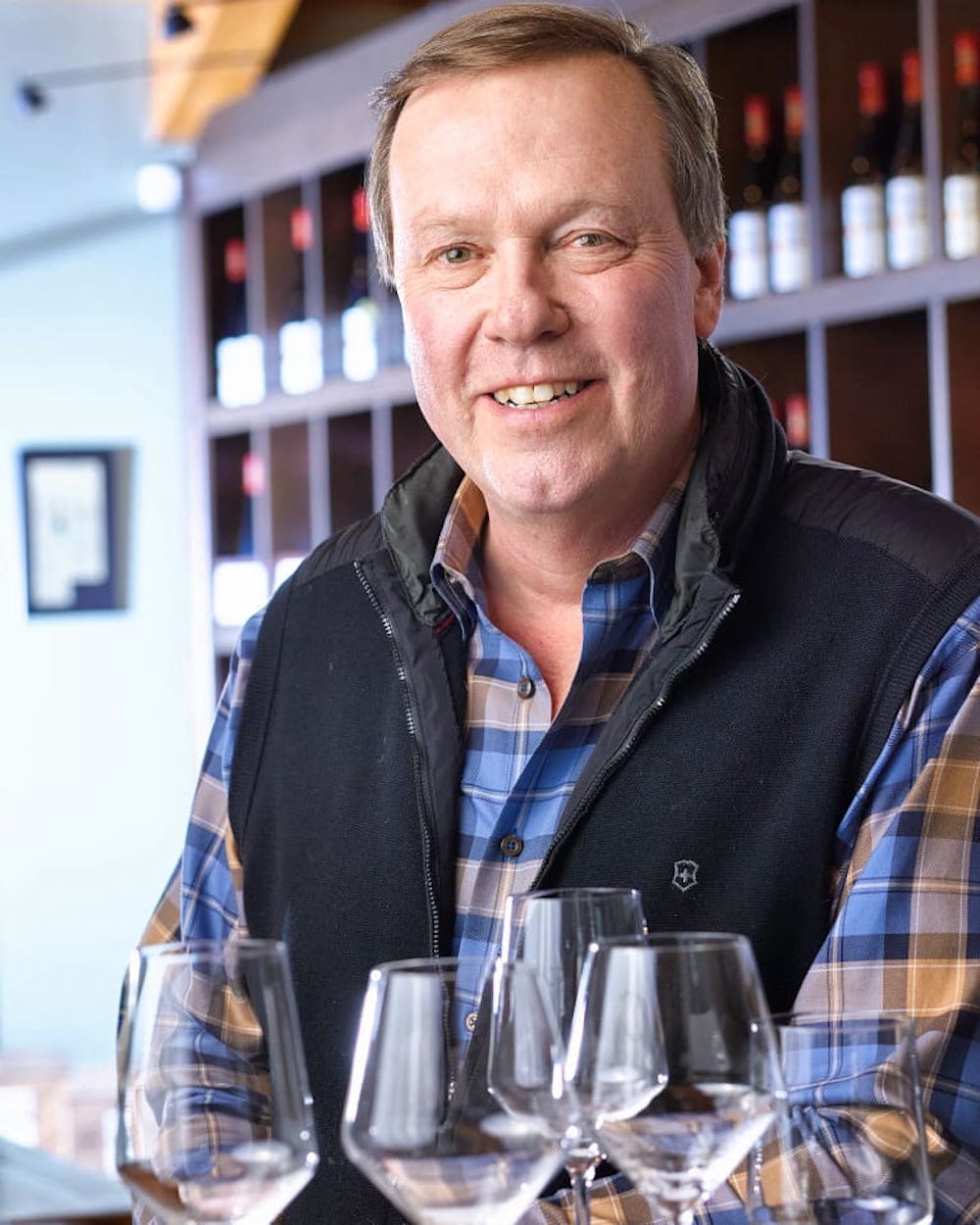
The 2021 harvest was a challenge like we have not seen for a number of years (2006?) as Niagara received about 580mm of rain in September, October and November. There was quite a bit of dilution in flavours and some breakdown in the fruit. Definitely, a year where estate producers who control their vineyards and who hand pick and sort fruit (like HB), and who took a generous “saigné” for the reds, should be able to produce some above average wines.
It is a bit early to see how good, but we are quietly confident that with attention to detail and care in the cellar it will be an average to good quality vintage after the excellent 2018, 2019 and 2020 vintages. The only exception at HB so far, is that we will not be producing any single vineyard Rieslings in 2021 as we do not feel the wines merit that designation this vintage.
Shiraz Mottiar, winemaker at Malivoire, Beamsville Bench
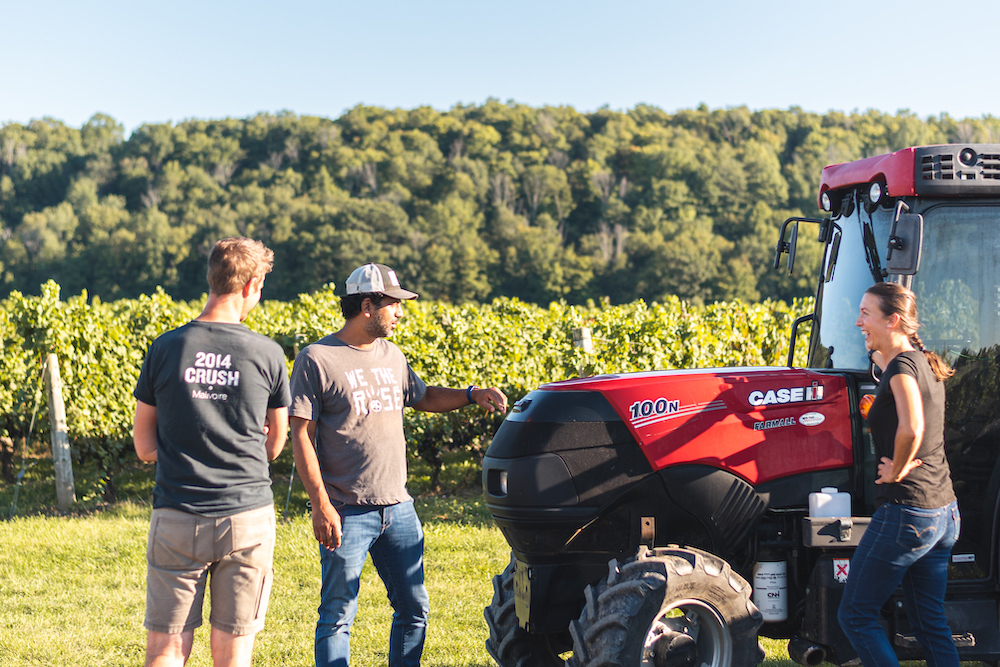
Well, the 2021 vintage was lining up to be a great follow up to 2020. We had a bit more rain during the summer, which really complemented the vines and cover crops and I thought for sure we would be picking in the 3rd week of August, but we had our usual dry spell and that slowed up the ripening.
We got some sparkling fruit off just before the 60mm rain that turned the season on its head (it is such a relief to do sparkling wine and get grapes off early). From that point on, the season was a haven for mushroom hunters, but not so nice for us grape growers.
It was so bad, that for one week in October, there was only fog. Literally – no sun at all! All that rain kept diluting the sugars in the grapes (except Gamay!) and all that humidity made it impossible to prevent rot from setting in. But we did manage to bring in tasty fruit. It might be a lower alcohol year, with less dense flavours, but the grapes were very well developed with the potential for good wine. Sorting and good clarification were necessary to keep the juice clean.
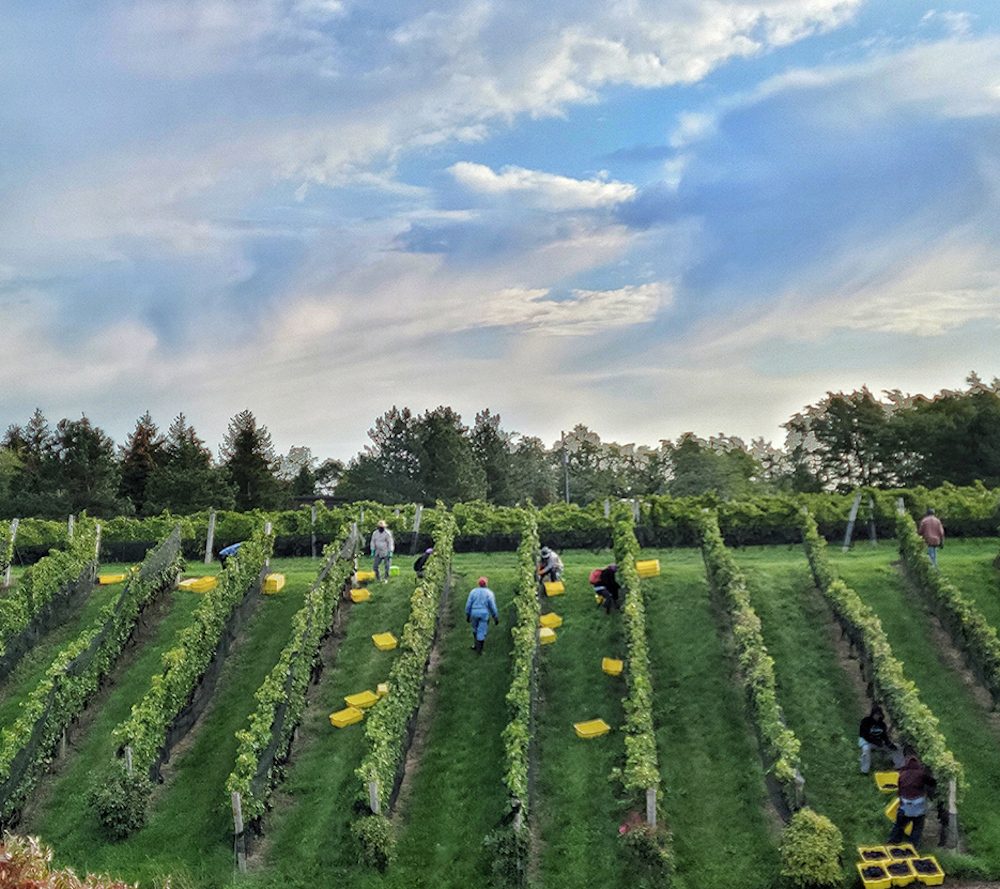
There were some heartaches throughout the vintage, like watching fruit fall apart that we couldn’t get to because the tanks were already full or dropping all the fruit from a vine because the clusters were “melting.” Despite losses in the field, 2021 was our biggest crop.
As I write this, we are bottling our Vivant and Rosé Moira, and both are spot on: fresh, vibrant and elegant. We have always believed in rosé, and I think there will be a lot of other winemakers who will too after a vintage like this.
Even though the Pinot grapes were plump, we could still get them off before they fell apart. In fact, because we like to pick early and not focus too heavily on brix, everything in tank or barrel is developing nicely. The reds may not be as dark or dense, but otherwise the character of the summer is shining through, and the wines are showing good promise. Early predictions for 2021 keepers: Gamay, rosé, Chardonnay and Gewurztraminer (those thick Gew skins are good in a year like 2021).
Kevin Panagapka, owner/winemaker, 2027 Cellars, Jordan
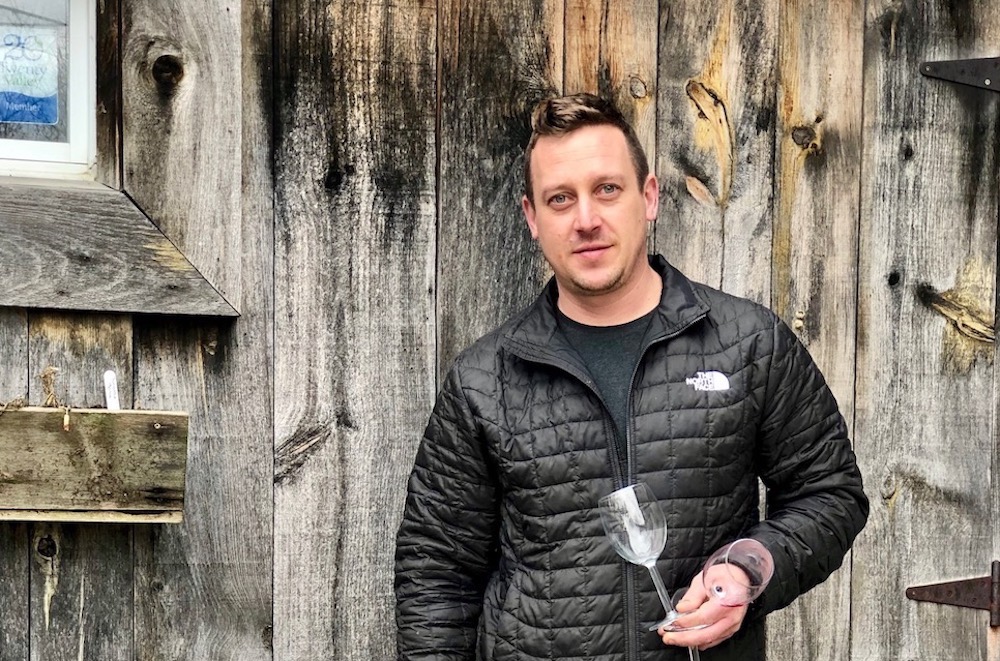
It was pretty good … until the botrytis set in. I’m seeing Chardonnay with potential to be quite good. Gamay also looks promising in our portfolio (both red wine and rosé).
The Cab Franc will be lighter in style from 2021 and we’ll see how the wines evolve over the next eight months, I’m confident we will see good wines from this vintage.
2027 Cellars scaled back production in 2021, so I didn’t make as much wine generally. I think you will see pockets of very good wines from specific vineyards and specific varietals.
We live in a cool climate wine growing region. As winemakers, we are used to dealing with challenges from vintage to vintage. There is always something that happens from year to year that you need to deal with (you just never know exactly what it will be). With the talent and experience of the winemaking teams in Niagara, I believe you will see some very interesting wines from 2021. It was a very tough vintage to manage in real time because things were changing so quickly in the vineyard. Well managed fields will produce quality wines (especially the early ripening varietals).
Jamie Slingerland, director of viniculture at
Pillitteri Estates Winery, Niagara-on-the-Lake
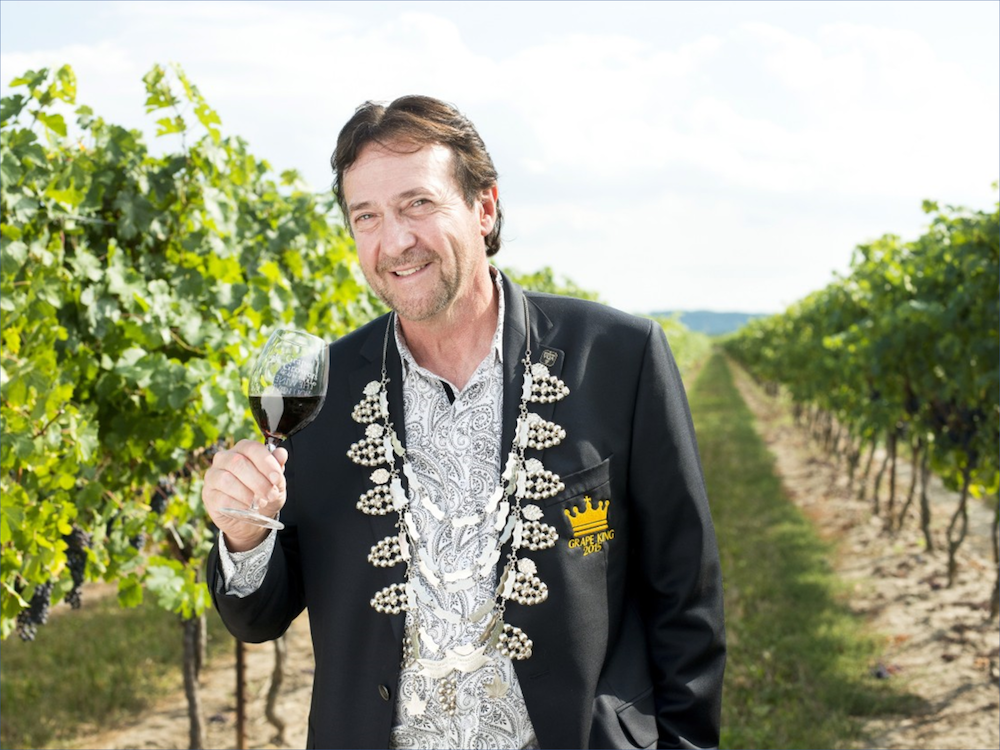
The 2021 vintage had a wide range of weather, starting off great and finishing poorly, which challenged growers and wineries. The winter from December 2020 to the start of February 2021 was much milder than in previous years. The hot weather of 2020 and early mild winter weather kept Lake Ontario waters a couple degrees warmer over the winter of 2020-21 than average, helping moderate the winter weather.
Pillitteri Estates Winery is the largest estate producer of icewine in Canada and the largest exporter of icewine in the world. I have harvested icewine grapes for 35 years and there are a few things I have learned. Most years, the majority of the icewine crop is harvested during the first couple of weeks of January with rare occurrences before Christmas and small amounts between Christmas and New Year’s.
Most often those early short windows of cold are skipped to obtain a full browning of fruit that results in superior icewine characters. The 2020 icewine vintage was small in size, and most growers/processors had to wait for cold weather toward the end of January 2021 to harvest the majority of icewine. This proved devastating for vinifera icewine grape varieties as they have thin skins and had become completely desiccated by then.
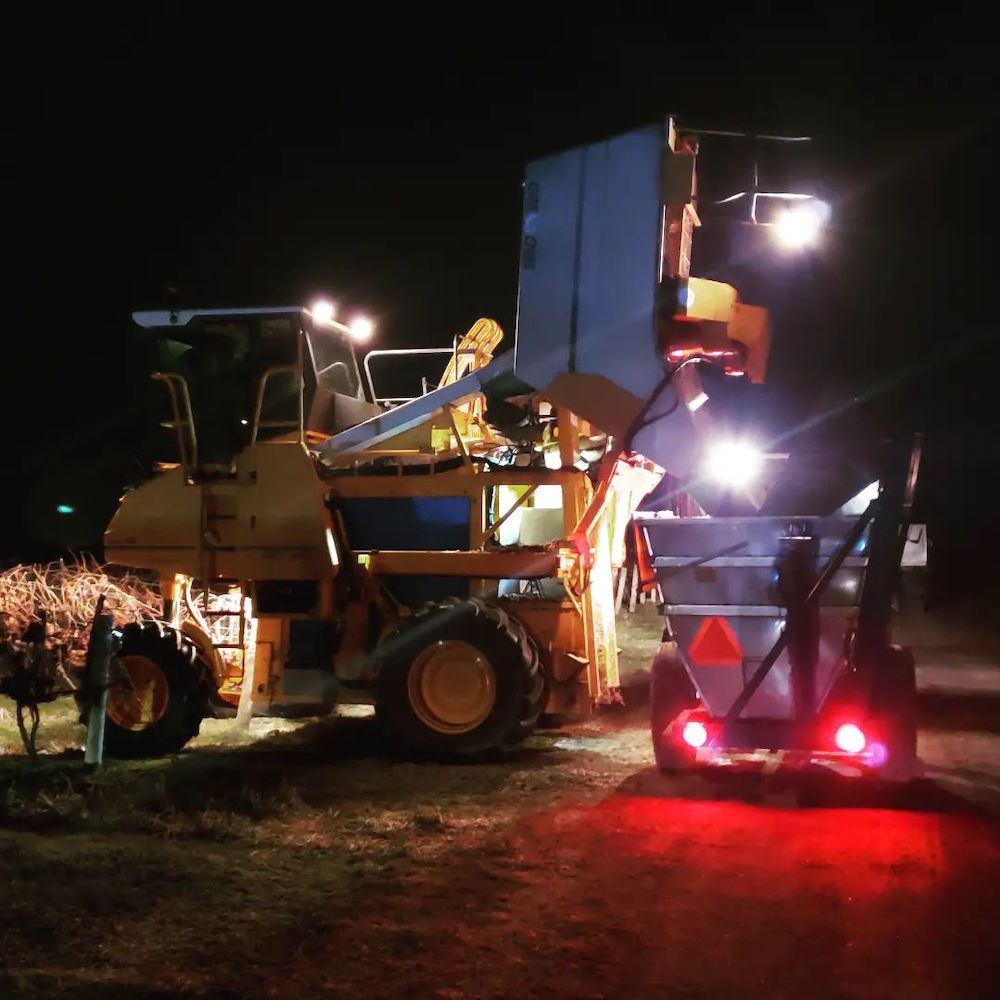
A rule of thumb is that if you don’t harvest your red vinifera icewine by the first week of January and the Riesling icewine grapes by the second week there is nothing left to harvest other than grape dust. Vidal grapes are a different story. They are the workhorse of icewine production not only because of their incredible aromatics and flavours but importantly for their thick skins that are more resistant to breakdown and desiccation thus allowing them to hang longer.
I have harvested icewine as late as March. Not ideal, as volumes were reduced to 25%. It would be safe to say that due to birds and dehydration in most years between 1-2% of the grape tonnage on Vidal is lost each day any time after December 31.
A sure sign of a mild winter is the little use of wind machines in winter. During the 2020-2021 winter the wind machines were barely used in Niagara as there were no extremes in cold. By March, it felt like spring had arrived with warmer than average weather continuing until April. May was average and by May 15 buds were swelling with little risk of frost in sight. This mild winter and the frost-free days after mid-May resulted in close to a 90% fruit bud survival in most varieties.
The 2021 winter was one of the higher fruit bud survival winters. Fruit bud survival rates of 65% can result in an average sized crop if evenly spread in the vineyard. Higher fruit bud survival allows growers the flexibility to determine their crop size as growers commonly thin shoots in June and thin fruit up until version in August.
To a degree, growers can manipulate the crop by the amount of fruit buds when pruning in the winter for a larger or smaller crop. They also shoot thin to reduce the crop (if there is a high fruit bud survival) and to eliminate secondary shoots that will produce immature fruit. If there is a larger than desired amount of fruit still on the vine, then the final thinning occurs at version to reduce crop and remove later maturing fruit. It is important to thin to the desired crop as early as possible to get better fruit quality. Most fruit removal after this is mostly secondary fruit and has little bearing on crop size but a major impact on overall harvested fruit quality.
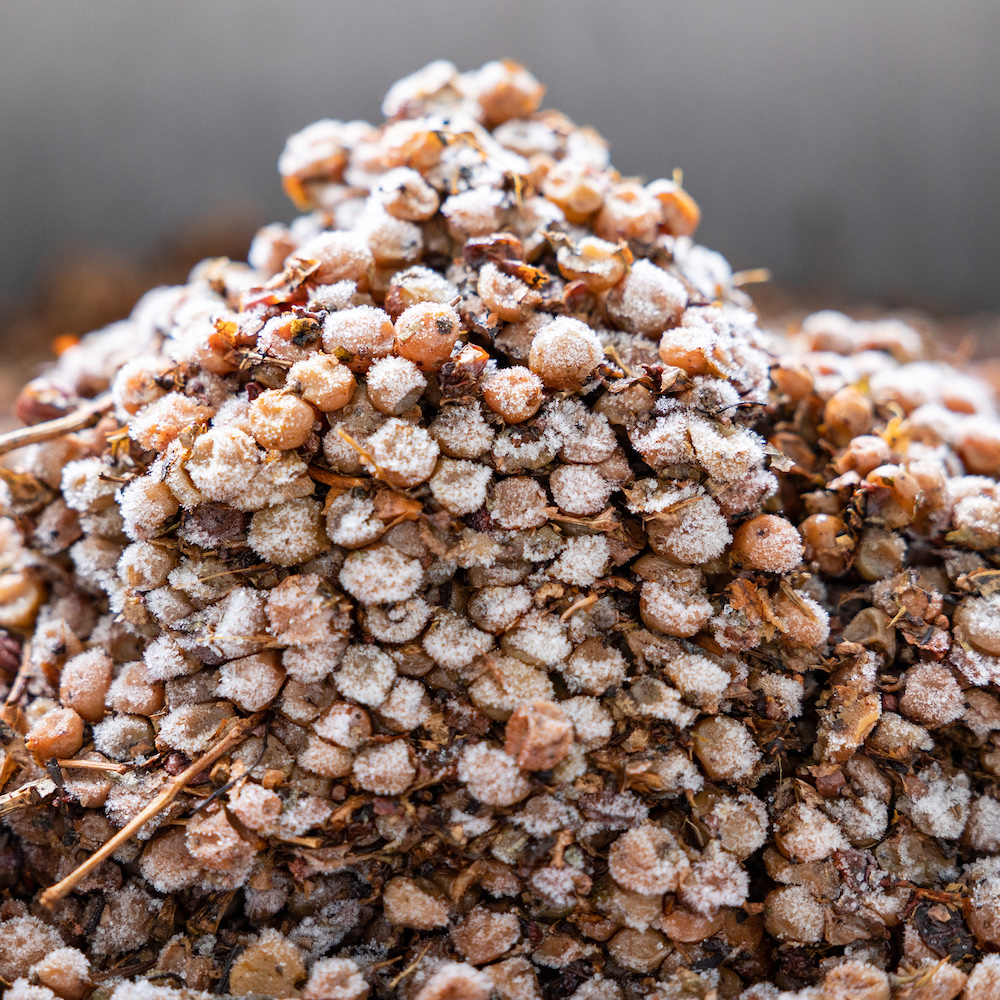
Weather in June was a bit warmer than average. Hot weather in July and August had the year shaping up to be a great vintage of not only quality but also quantity.
Starting in late July to August, many growers began to irrigate to relieve stress on vines especially those with big crops and young vines. Many growers also felt comfortable not irrigating, due to good moisture reserves in the soil from the winter/spring. It’s not good to irrigate grapes close to harvest. I did not irrigate believing my vines were in good condition and not suffering. As well, because upcoming two-week forecasts showed rain in early September. Those rains did come and more than expected. In the last few days of August, rain began and continued for September and October when most of harvest occurs.
Weather was warmer in September and October, which increased the uptake of moisture to the fruit.
There was 50% more rain than the 10-year average in those 2 months. After a prolonged period of dry weather like that in summer 2021, the first 1-2 inches of rain disappeared within a few days with little impact on grape quality. So, the rain at the start of September 2021 was a relief rather than a hindrance. By the start of October, rain had become a hindrance. Rain with cool weather in the fall time is common with grape harvests in Ontario. Rain with warm weather in the fall is not.
Viticulturalists and winemakers sample grapes prior to harvest looking for four key, fruit ripening factors, higher Brix, lower acidity, higher PH and browning seeds.
Obtaining higher Brix and seed ripening can occur at the expense of lower acidity, as acid can be added, but if fruit is unripe, it’s hard to remove acidity without removing flavour. Better to hang the grapes a week more than to harvest a week too early.
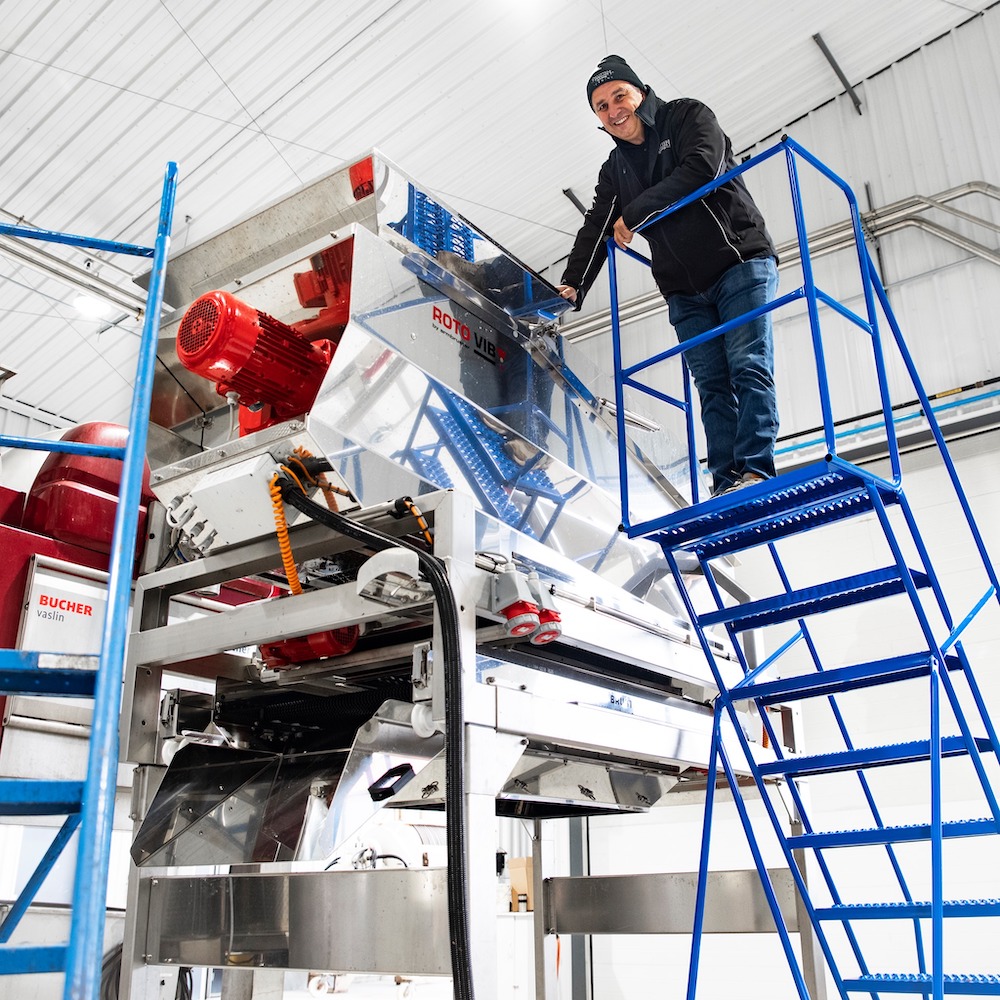
Excessive rain can have a diluting effect particularly on Brix and fruit characters and it can also add weight to the berries and more so in warmer weather. If the luxury exists, winemakers will try to either harvest before a 1-inch rainfall or wait 4-5 days until soil conditions return to dry conditions and grapes continue to desiccate. When it rains every 3-4 days and it is warm, like it was in September/October 2021, the drying out effect doesn’t happen, and risk of splitting berries is higher. A lot of times cooler weather in the fall is common allowing for a slower absorption of rainfall. In September and October 2021, the warmer than average temperatures combined with rainfall was not a positive factor.
Winemakers, at first, delayed harvest on most varieties hoping for optimum conditions to return. The waiting changed from a few days to a week and then more days after that. As a result, harvest was delayed, and precious processing days were lost, thus prolonging the season.
Split berries are a very rare occurrence in well drained fields as most grape producers have underground tile drainage 18-24 inch deep in every row in their vineyards. Tile drainage is an ancient practice in agriculture to remove excess rainfall and is a practice dating as far back as 3000 BC in Egypt, India and China.
A well-drained field allows grape vine roots to “breath” and not “drown.” It also encourages a larger deeper root system that accesses more minerals and nutrients. Grape vines and ripening fruit can recover quickly to an occasional or average rainfall but do not respond positively to saturated soils. Saturated soils in 2021 became common, impacting many later varieties causing grape splitting as fruit ripened.
As ripe berries began to split, many wineries, on varying fields and varieties, determined that Brix would not increase, acids had sufficiently dropped, PH had risen enough, and it was best to harvest clean fruit before white mold, breakdown and botrytis occurred. Thus, harvest, which was delayed now, became accelerated.
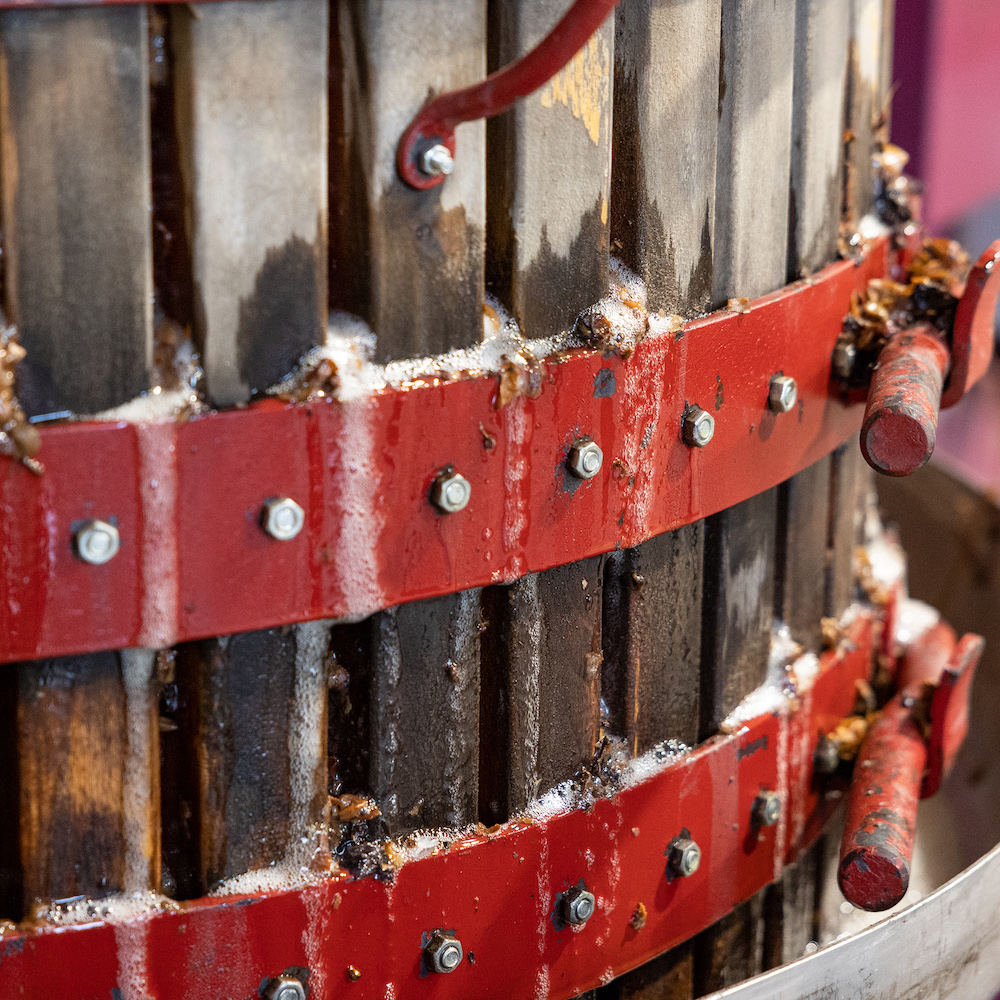
It was the first time many wineries, ours included, experienced harvesting many varieties in a shorter period. In 2021 it was not uncommon to see Merlot, Cabernet Franc, Cabernet Sauvignon and Shiraz harvested within 7-10 days rather than typically, over a 3+ week period. That created capacity issues for red fermenters. Growers and wineries are innovators and where there is a will there is a way.
Timing of harvest, disease control and talented winemaking were determining factors to a successful vintage in 2021. There were a lot of very good grapes harvested in 2021 that will produce good varietals. As well, there were a lot of grapes that were harvested under less-than-optimal conditions, and they will become entry level wines.
The appassimento grape harvest of 2021 by many wineries was significantly scaled back including ours by 75%. Those grapes harvested had to be handled like eggs ready to break open. We succeeded in harvesting our Italian varieties of Corvina, Rondinella and Molinara. We were more challenged by our Cabernet Franc and Merlot, which fortunately, benefited from a trial use of a thermal vinification machine.
The 2021 vintage icewine harvest was small and completed by the second week of January 2022. It was another small crop at 2,000 tons, 40%, of the 5,000+ ton 10-year average and double 2020. The doubling of the tonnage from 2020 to 2021 cannot be speculated as an increase in demand but a lot of surplus grapes were left on the vine by growers in the hopes of finding an interested winery.
Prince Edward County
Dan Sullivan, owner/winemaker,
Rosehall Run Vineyards
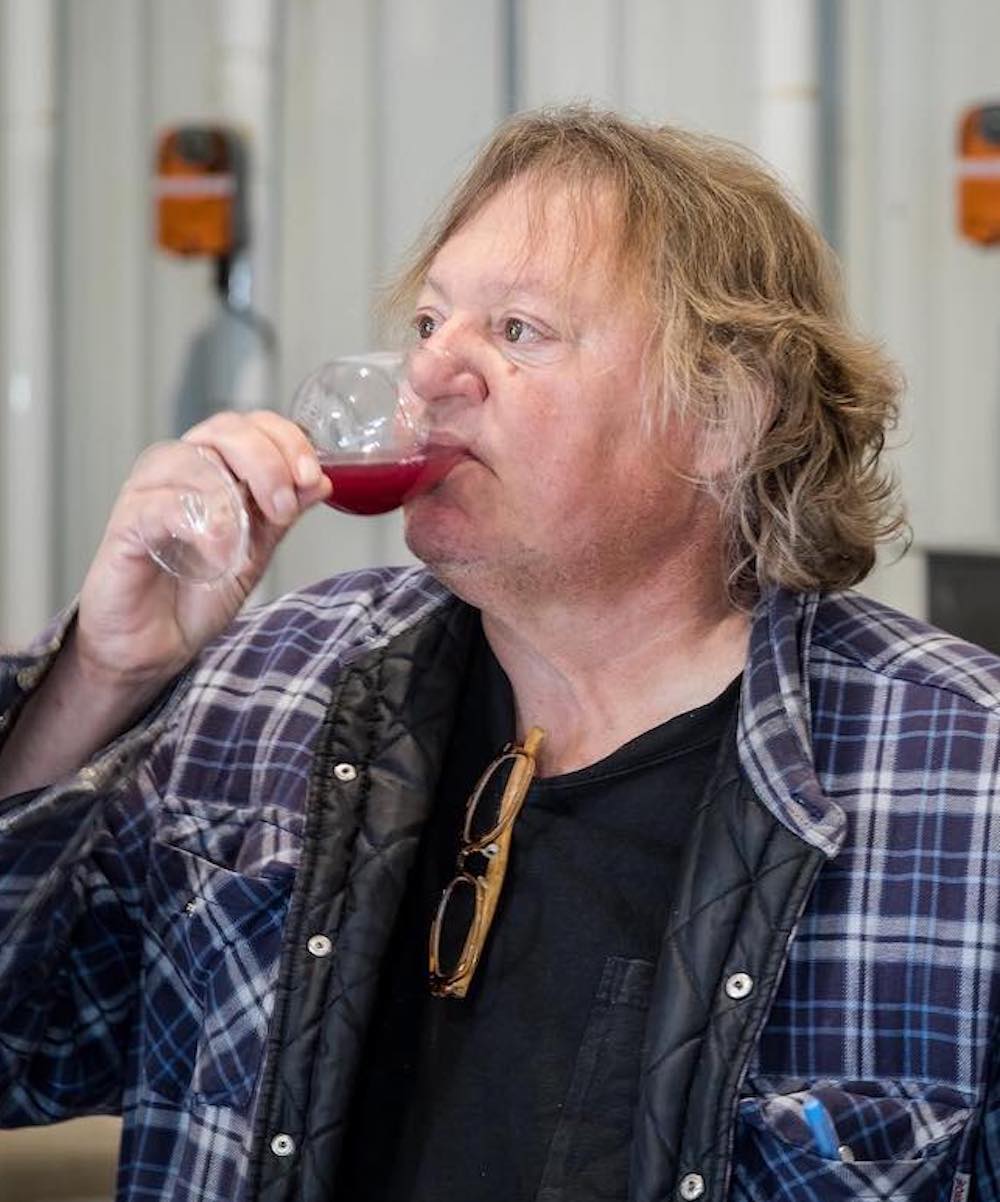
And so it began for the 2021 grape harvest in Ontario. By the second week of September, it was shaping up to be a fine and abundant follow up to the stellar but short 2020 vintage. By most accounts, yields were shaping up to be about 30-50% larger in 2021 and both growers and wineries were cautiously optimistic that we might have our cake and eat it too in ’21.
But then it rained. It rained biblical.
It was then that the tale of ’21 started to unfold in real time. That large crop became both a blessing and a curse. The handwringing, teeth gnashing and wailing about impending doom began. For some, and some varietals, it was justified as a lot of mid-season whites like Chardonnay and Riesling took it on the chops. If you weren’t on your game in the vineyard earlier in the year or just plain greedy about crop load you got hammered. If you had a balanced crop, it allowed you to pick a little early ahead of the rain.
This was the case for the most part with our Pinot Noir at the home farm here in southwest PEC. The earlier fruit proved to be the most concentrated and is shaping up to be an excellent vintage, the later picks still came in clean, and we were spared one blast of precipitation that tracked south allowing us to pick for rose quickly followed by the rest of the crop for a second lot, that while a bit less concentrated, is nevertheless ripe and clean with good varietal expression.
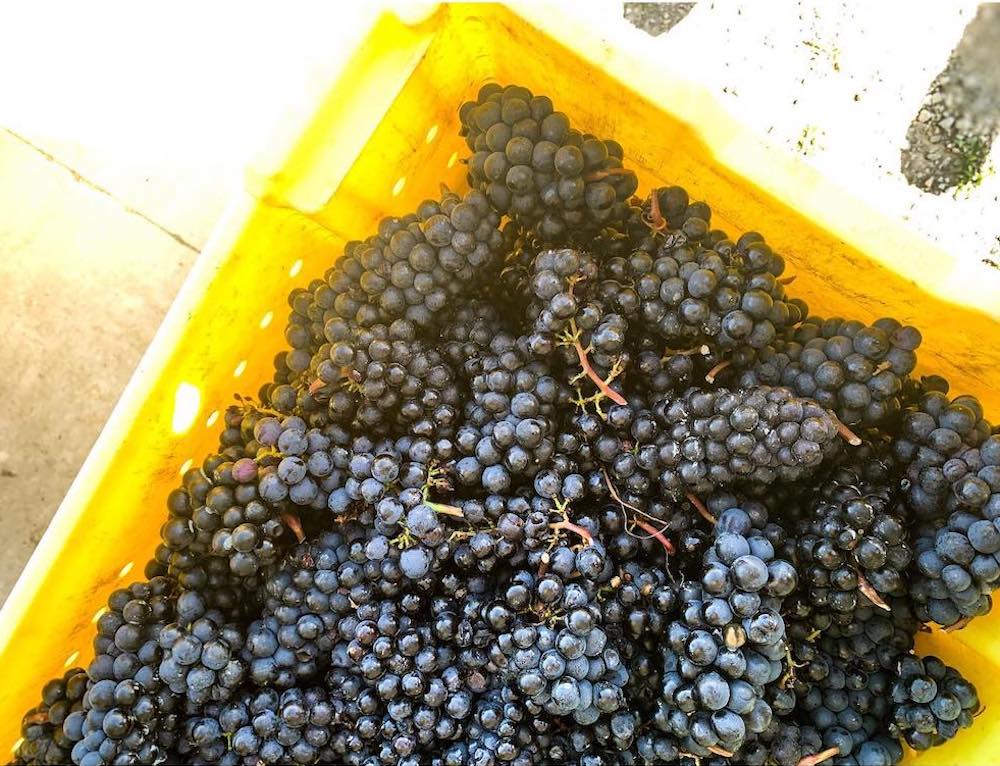
“The reports of my death have been greatly exaggerated.”
— Mark Twain
That is the thought I’m left with regarding the harvest. It is also the never-to-be-realized wish that begins 2022. Godspeed Paul, it is still raining in my heart.
I think 2021 will be variable, but I also think that the best producers will perform the best and there will be some surprisingly good wines, particularly Pinot Noir, sparkling, early picked Riesling and Chardonnay.
At this point, I think the 2021 reds taste riper than 2019s and will be very pleasant for early drinking, which is not at all a bad thing while you wait for your 2020s to round into form.
I believe vintages like 2021 will display how far modern grape growing and winemaking has come here in Ontario as more and more quality focused operations apply the skills and tools we have developed in the last 20-30 years.
As always, good harvest decisions and winemaking will make the difference.
Mackenzie Brisbois, winemaker at Trail Estate,
Prince Edward County
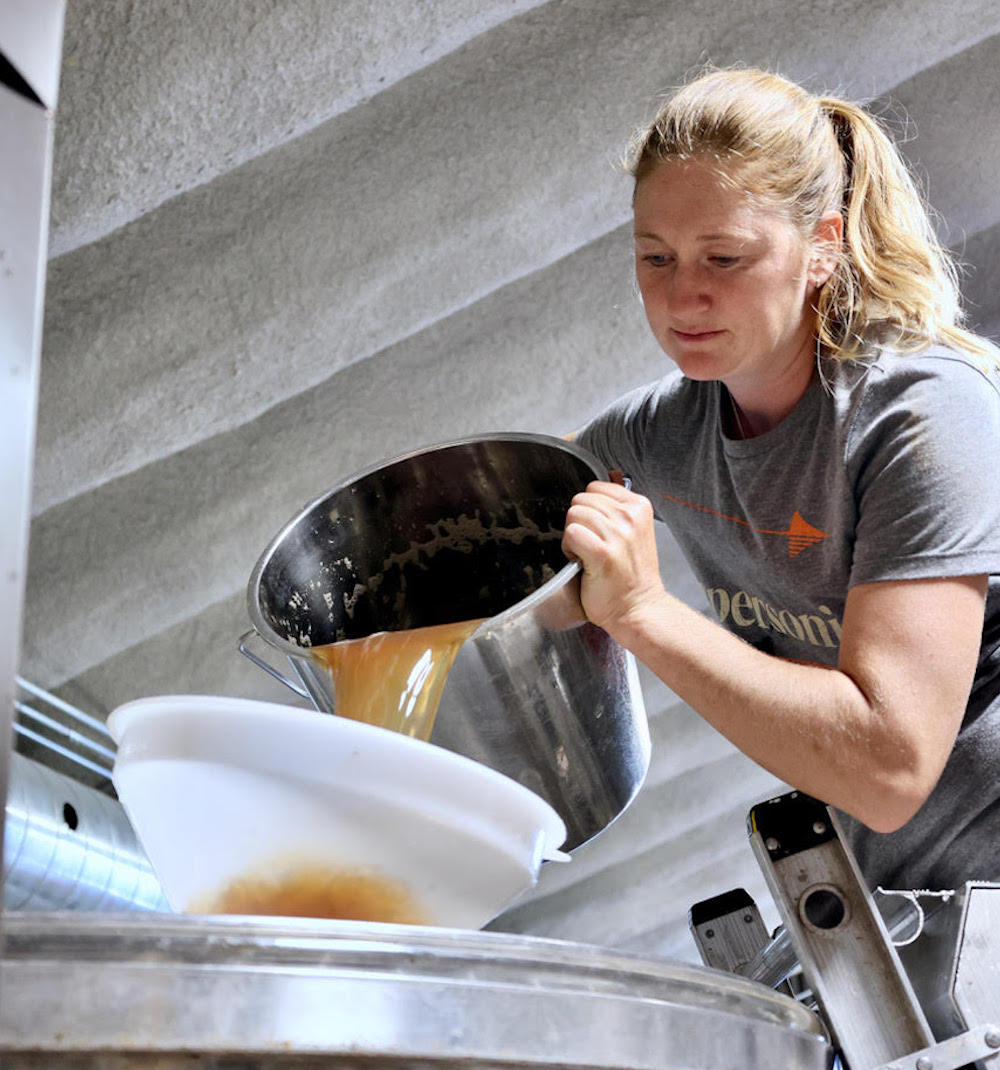
Harvest 2021 certainly had a few ups and downs. The harvest could almost be divided into 2 sections — before the rain and after the rain. Early varieties seemed to fare the best, benefiting from hot and dry conditions towards the end of summer.
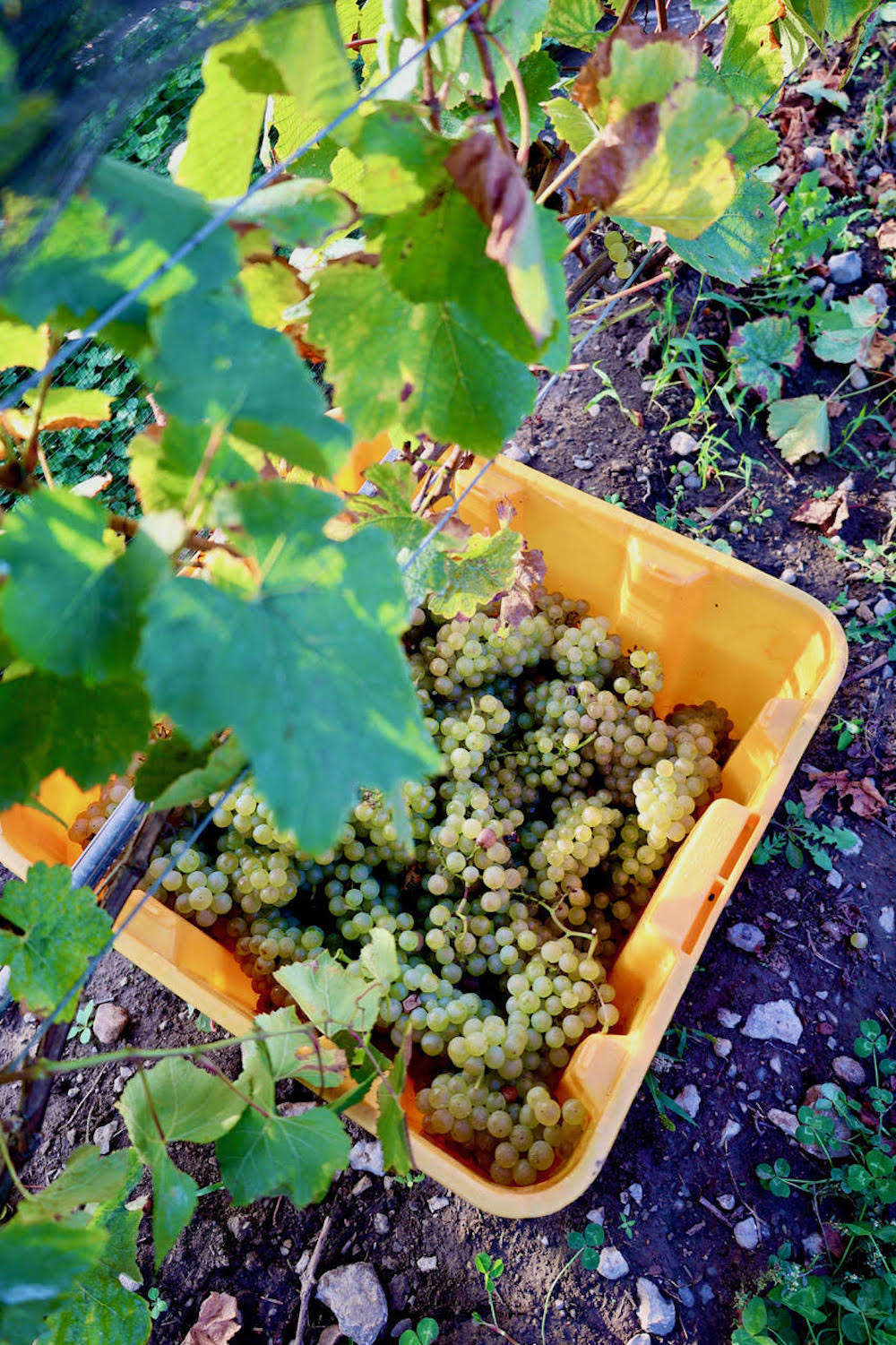
Later ripening varieties, like Cabernet Franc, will be higher in acid and will definitely be more interesting than normal years. Mid-way through harvest, we got hit with challenging weather conditions and a quick step was needed to bring in the fruit. Tireless effort from growers and pickers made all the difference in the quality of the 2021 harvest. The wines to watch from 2021 will be Chardonnay and Pinot Noir!
Andre Gagne, proprietor/vigneron,
Last House Vineyard, Hillier Ward, Prince Edward County

Harvest 2021 was the third harvest for Last House Vineyard. It was also the first harvest with a full complement of grapes coming from the newly planted vineyard, then in 4th leaf. This meant that the full 5.25 acres were finally in production.
The story of the 2021 harvest in PEC starts in the winter of 2020/2021 with the mild weather.
The cooling off in the fall was gradual, allowing vines to fully acclimatize for winter. Temperatures never got down to bud-killing levels. By the time March rolled around, it was clear that even though we had a full complement of reserve canes buried under soil, that we would be using aerial canes as well.
When the early spring pre-prune started, we purposefully left 1 or 2 unburied canes per plant. When canes were tied to the fruiting wire in late April, we favoured those canes that had never been buried and had a full complement of healthy buds. Little did we realize how heathy they were.
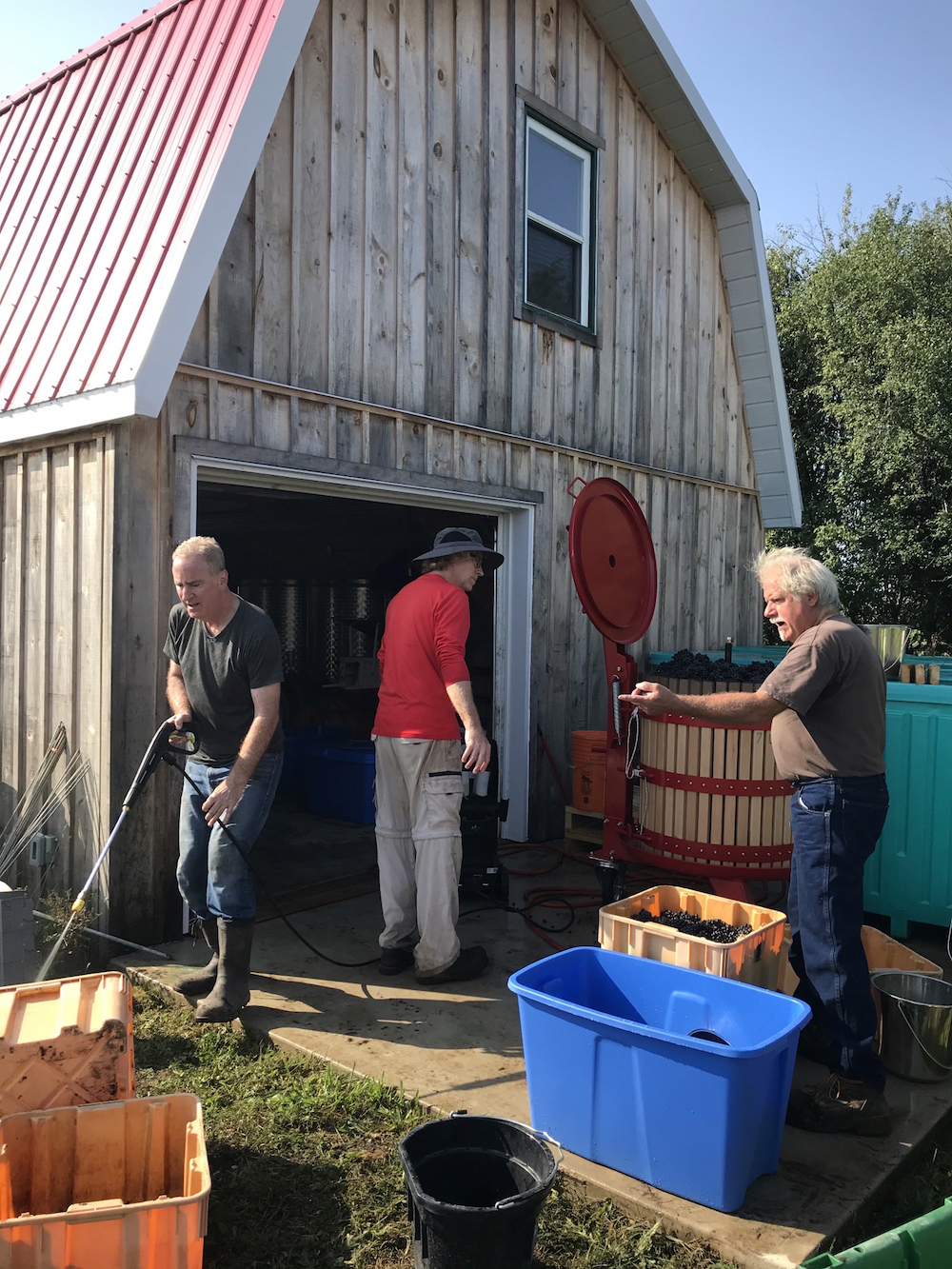
The 2021 growing season was a bit upside down, with hot drought conditions in June and too much rain during a cool July. The disease pressure after July was quite high and did not allow is us to be fully organic in our spray regimen. In addition, the leafhoppers came in waves, and we had to spray for that as well. A lot of work in the vineyard did allow us to maintain a healthy canopy right into November, so again, the vines were well prepared for winter.
The harvest came a bit early for PEC, starting in the last week of September. The mild winter did its magic, and the crop load was very large. Too large in retrospect and we should have reduced it more than we did. Ripening was running behind, so picking was spread over 3 weeks, with the early pick focused on sparkling and a new entry level tier of wines made from both Pinot Noir and Chardonnay. As the picking progressed, we were able to make our flagship Pinot Noir and Chardonnay at ripeness levels that will qualify for VQA Prince Edward County. But it was close, and a portion of the early pick will have to be labelled VQA Ontario. The rains over harvest worked against us in terms of achieving desired total brix. They also caused a rapid onset of rot which forced us to go faster than we may have liked.
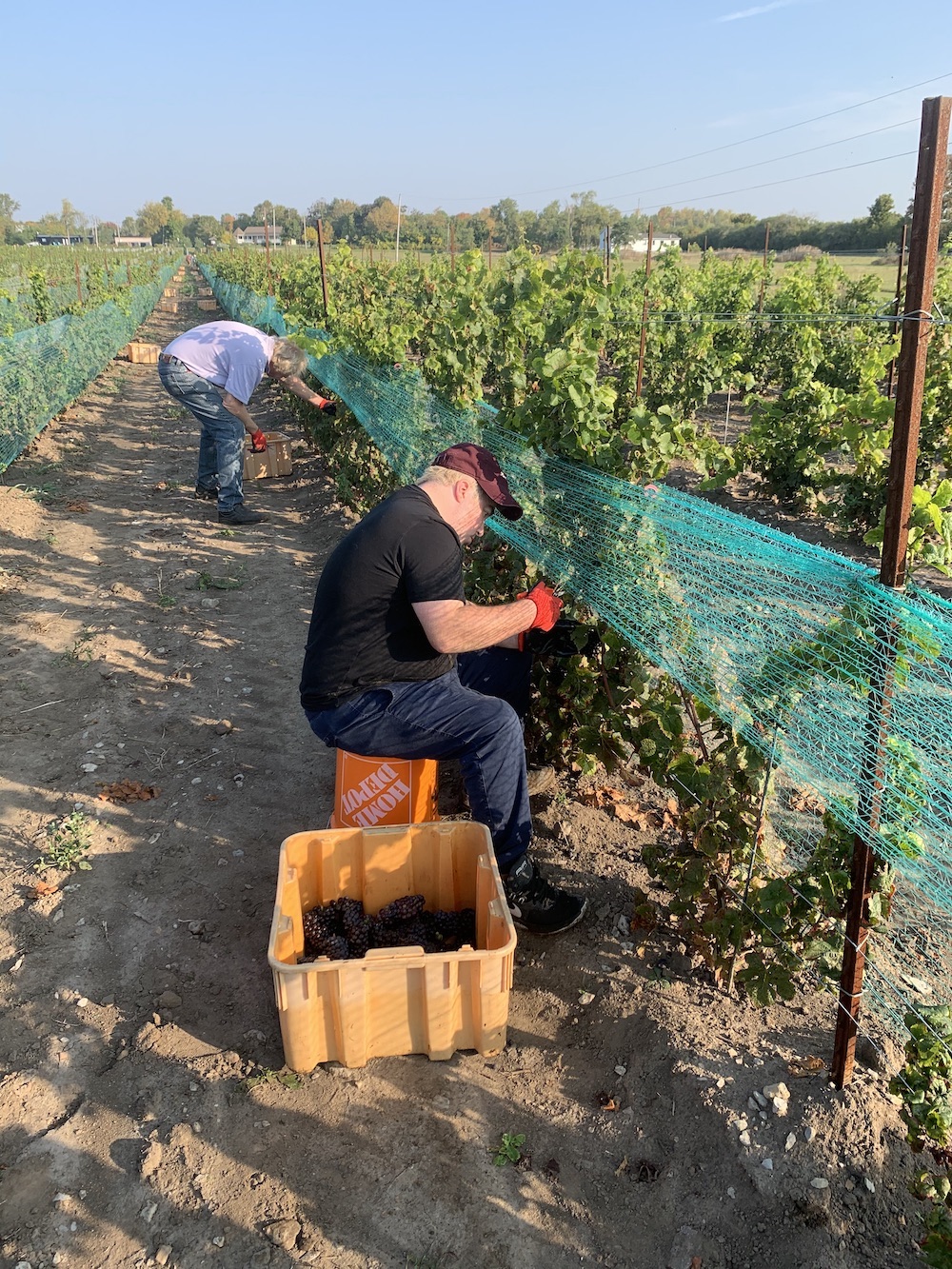
The volume of fruit was such that it could not be processed at the home winery. Three other wineries took part of the crop and incorporated it into their 2021 program. Lesser clusters were left behind and had to be dropped after harvest. We had expected to reach full production of 600 cases per year in 2022. In fact, we could have exceeded that volume in 2021 had we been able to process all the fruit. In order to process what we did, we made 5 different wines from Chardonnay and 2 different wines from Pinot Noir. In the Chardonnay line, there are two new wines including a Blanc de Blanc Traditional Method and a Skin Fermented White. One of the Pinot Noir wines is akin to an Alsatian Pinot Noir. These will be very good wines. The more traditional Pinot Noir and Chardonnay are showing well but are not yet at the level of the 2019 and 2020 vintages. Careful elevage will be undertaken to allow them to maximize their potential.
At Last House Vineyard, we grow Chardonnay and Pinot Noir exclusively. In our opinion, the 2021 vintage favoured Chardonnay. With five versions of Chardonnay made this year, we are evolving into being a Chardonnay specialist. But Pinot will always be an important part of our mix.
We are still new at this and looking back on the 2021 harvest, we realize that we were blessed in 2019 and 2020. But that is real winemaking; there will always be vintage variations. Make the wines that the fruit allows you to make each year and make them honestly. In doing that, all will be fine.
Other Ontario wine regions
Brian Hamilton, winemaker, KIN Vineyards, Ottawa Valley
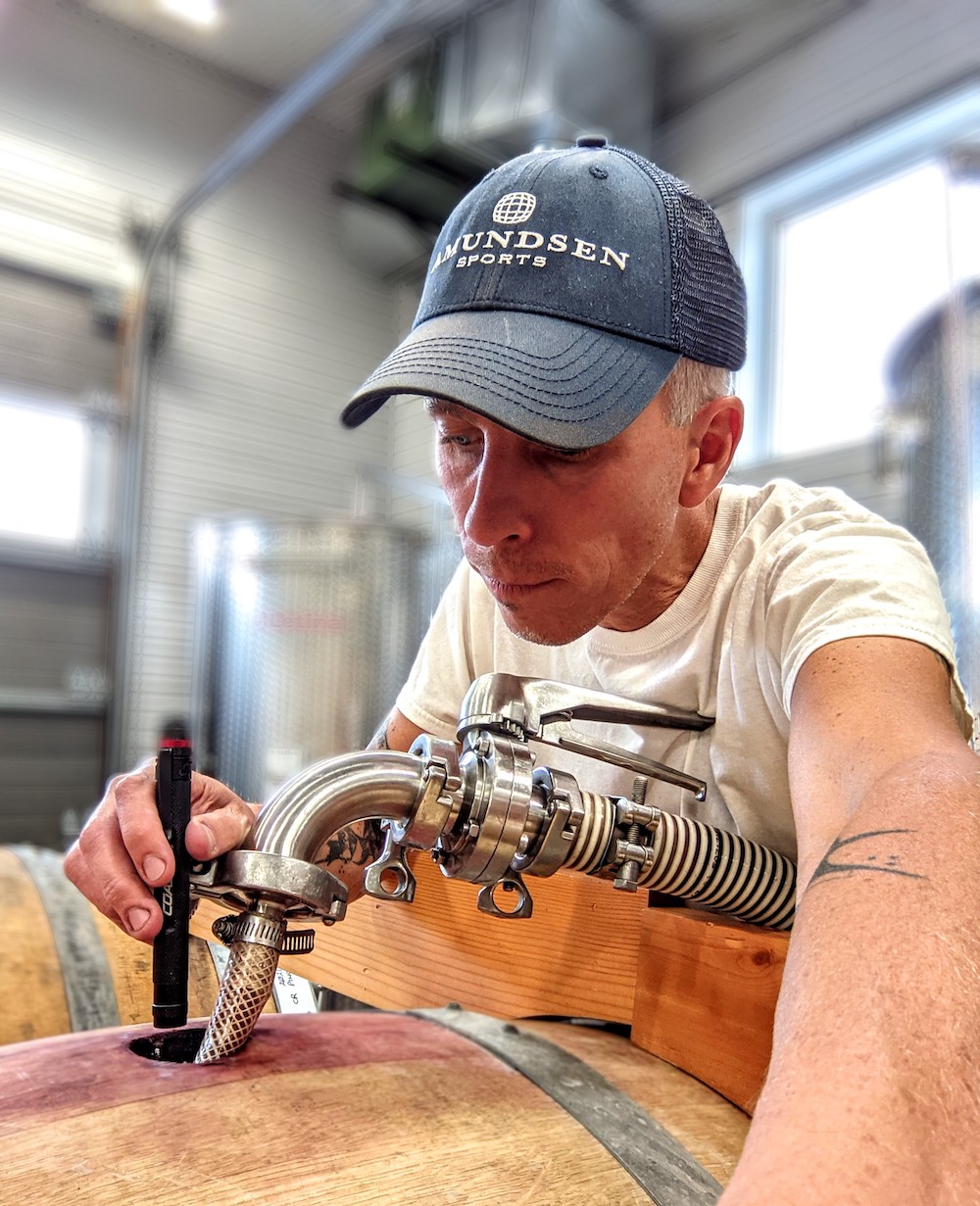
The season began with unearthing the vine canes and tying them to the fruiting wires around April 10 and for the following two weeks.
Weather warmed quickly in early spring and by May 15 we saw bud break at Carp Ridge. This was a typical bud break window for the vineyard. Warm weather continued after bud break with rapid shoot growth well ahead of typical. A late frost on May 28 saw damage to about 30% of the vineyard primarily in our low-lying Bottom Block of Chardonnay and the lower margins of our Middle Block Pinot Noir.
Our focus turned to maximizing the fruit set and crop yield of the healthy vines using French formulations with seaweed extracts. The results were terrific and the canopy size and health as well as yield and Brix, of the grapes, were record high over previous years. Chardonnay cropped at 1.7 tons/acre and Pinot Noir at 2.3 tons/acre, on our best blocks.
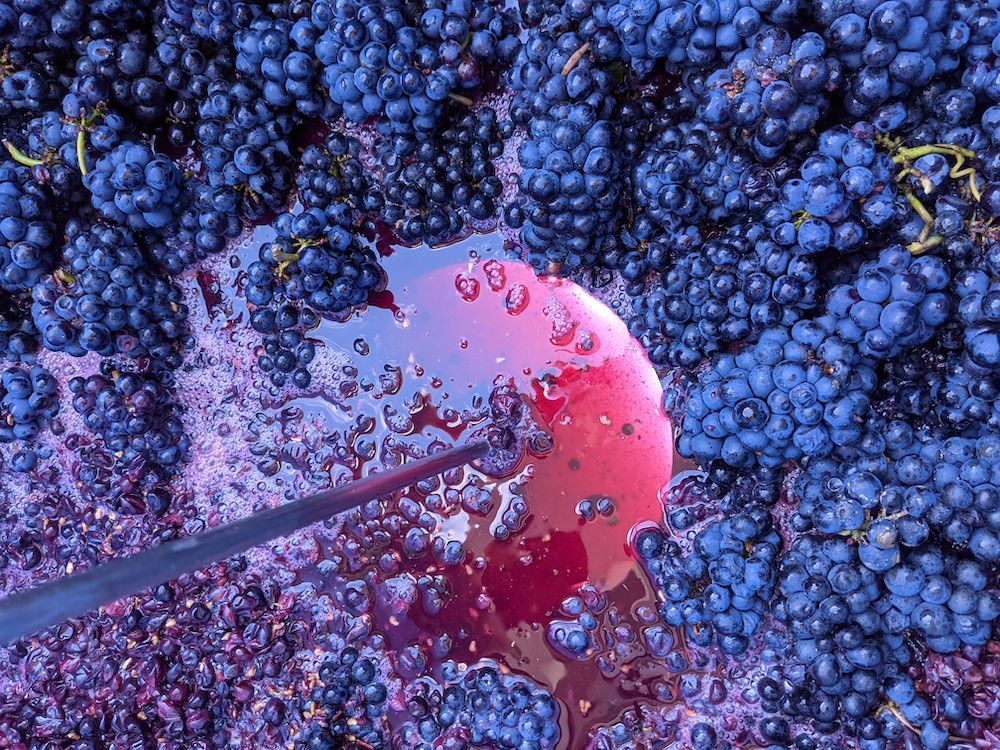
Sunny weather and well-timed rains kept the vineyard and fruit in good shape. Our biggest challenge was in finding sufficient local labour to accomplish vineyard tasks at an optimal pace. We will be bringing in migrant labour this year to make vineyard operations both more efficient and affordable.
• Flowering began June 8, a typical window for this vineyard;
• Veraison started August 6, about a week earlier than normal;
• Post veraison, there was typical pressure from downy mildew and black rot which could be reasonably managed, but very high pressure from wasps damaging the grapes. Early season warmth saw large hives with late season sugar requirements to sustain them later in the season;
• Harvest began with Pinot Noir on September 18, about two weeks earlier than normal. Weather was dry and fruit quality high. One week later, Chardonnay was picked on September 25, again, conditions were dry and fruit quality high.
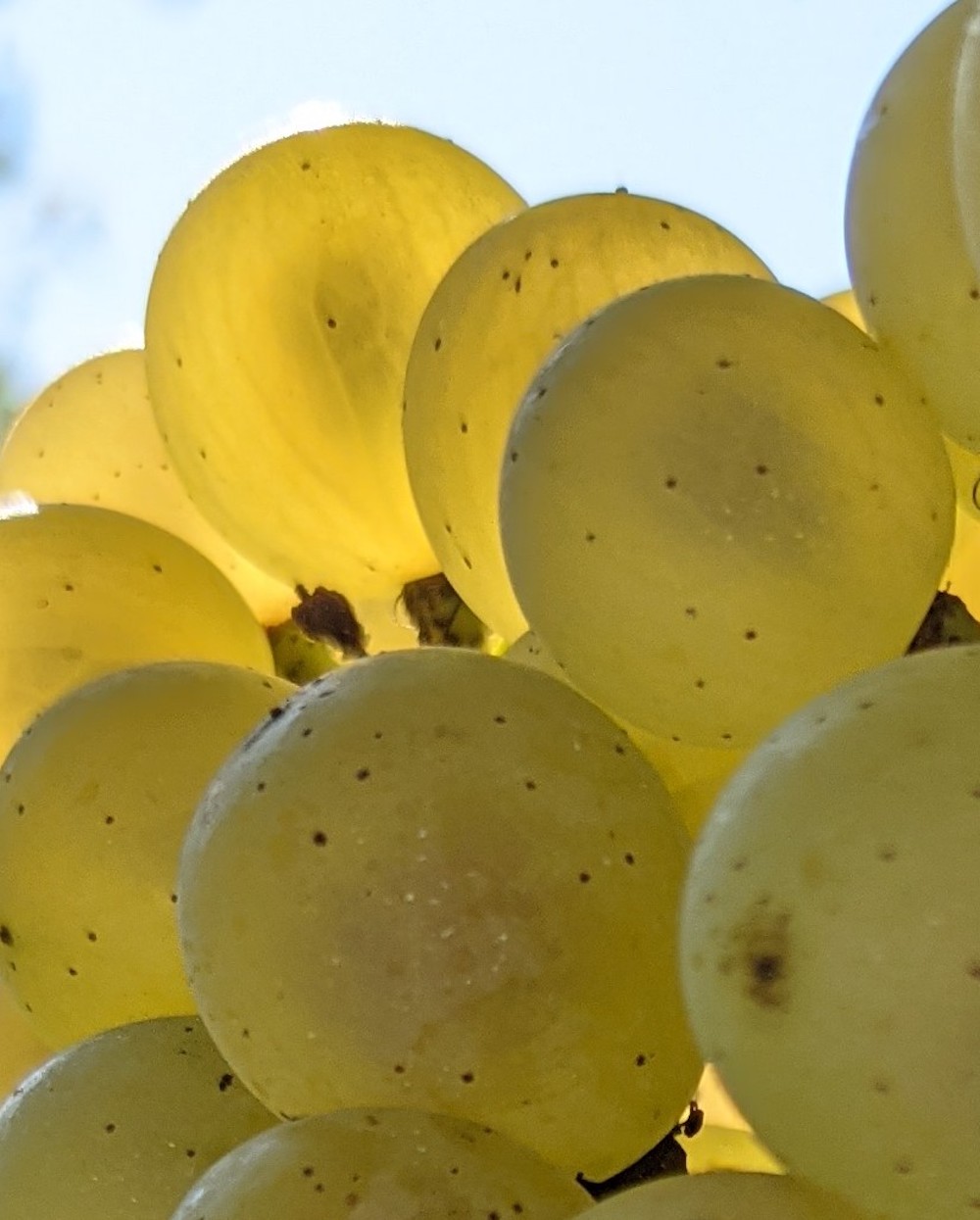
We produce three wines from Carp Ridge grapes: Chardonnay, Skin Fermented Chardonnay and Pinot Noir. We grow organically and biodynamically (not certified) and our wines are made with minimal intervention. Indigenous fermentation and malolactic conversion are used as much as possible with an elevage of 10 months in French oak barrique for both the Chardonnay and Pinot Noir. The Skin Fermented Chardonnay is a natural wine bottled with lees after seven months in stainless steel tank.
KIN Vineyards Carp Ridge Vineyard, planted in 2014, is now entering its ninth year and the quality of the wines continues to increase in both quality and distinctiveness. The Carp Ridge Chardonnay, from this warm vintage, will show a greater richness but with less new oak at 15%, while the Carp Ridge Pinot Noir (25% new oak) shows greater colour, structure and depth of fruit with each passing vintage. The 2022’s will be very exciting, indeed!
David Eiberg, winemaker at Therianthropy, Creemore
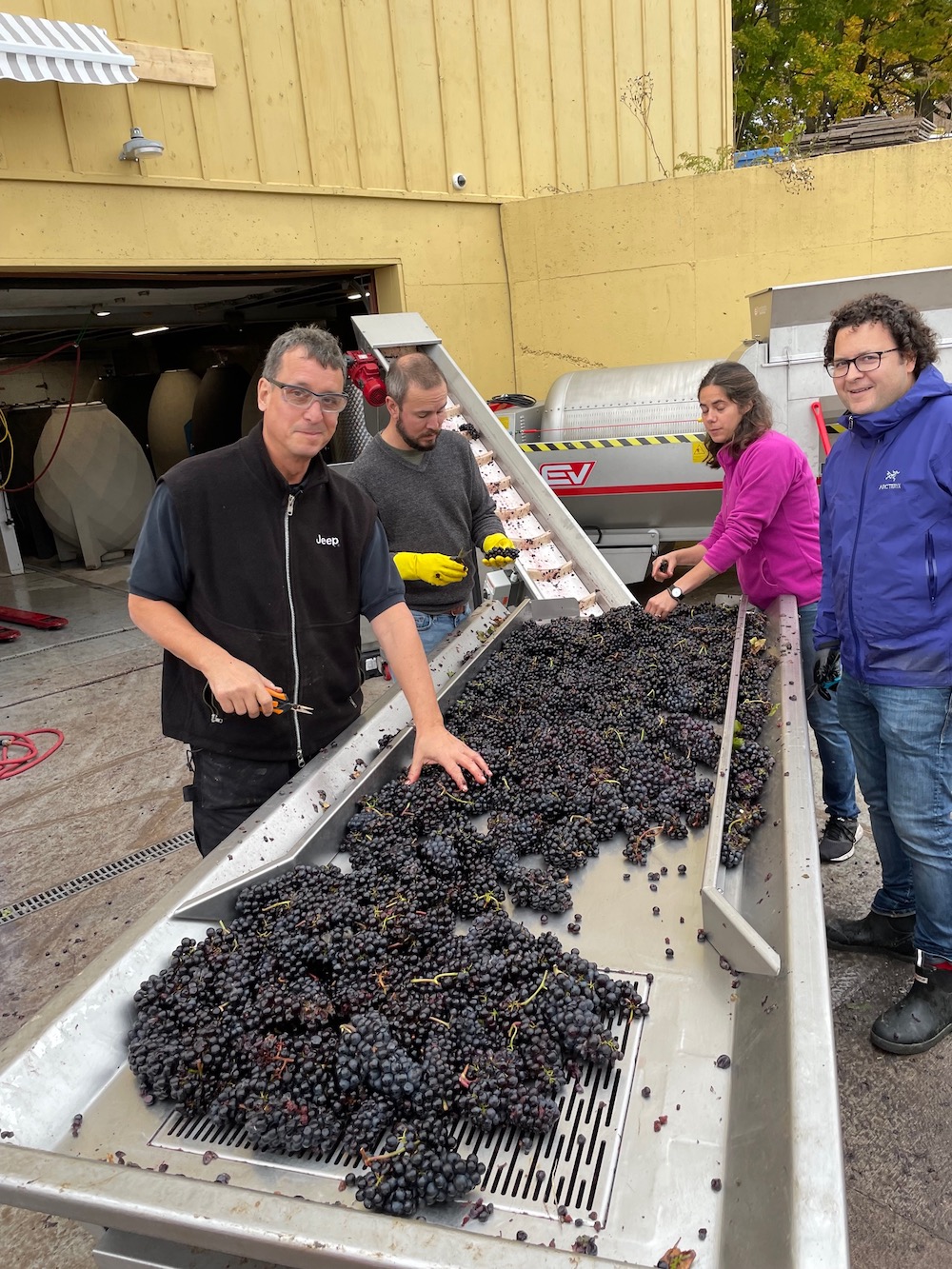
2021 was a pretty decent harvest for us after an unpredictable growing season. The challenge was mostly rain and then also lady beetle outbreaks on a couple of sites late in the season, but we got through it all OK I think in the end. We did modify our approach a little, given all the rain in the fall, harvesting earlier than usual for most varieties.
I don’t think 2021 was a year to just let it hang. In general our alcohol levels are lower than previous years as a result, and the wines are less fruit forward but so beautifully nuanced with floral, earthly and gentle spicy notes. Phenolic ripeness was good and acids levels are also very much where we like to see them – medium-high in relative terms.
I’m really excited by this vintage because these are the kinds of wines I really love to drink. I think the whites (especially Riesling, Chardonnay, Viognier and Muscat) and earlier ripening reds (especially Gamay, Pinot Noir and Zweigelt) are showing the best but we also got really lucky overall with where our growing partners are located, and we have some Cabernets from St. David’s Bench and Grimsby which came through beautifully.


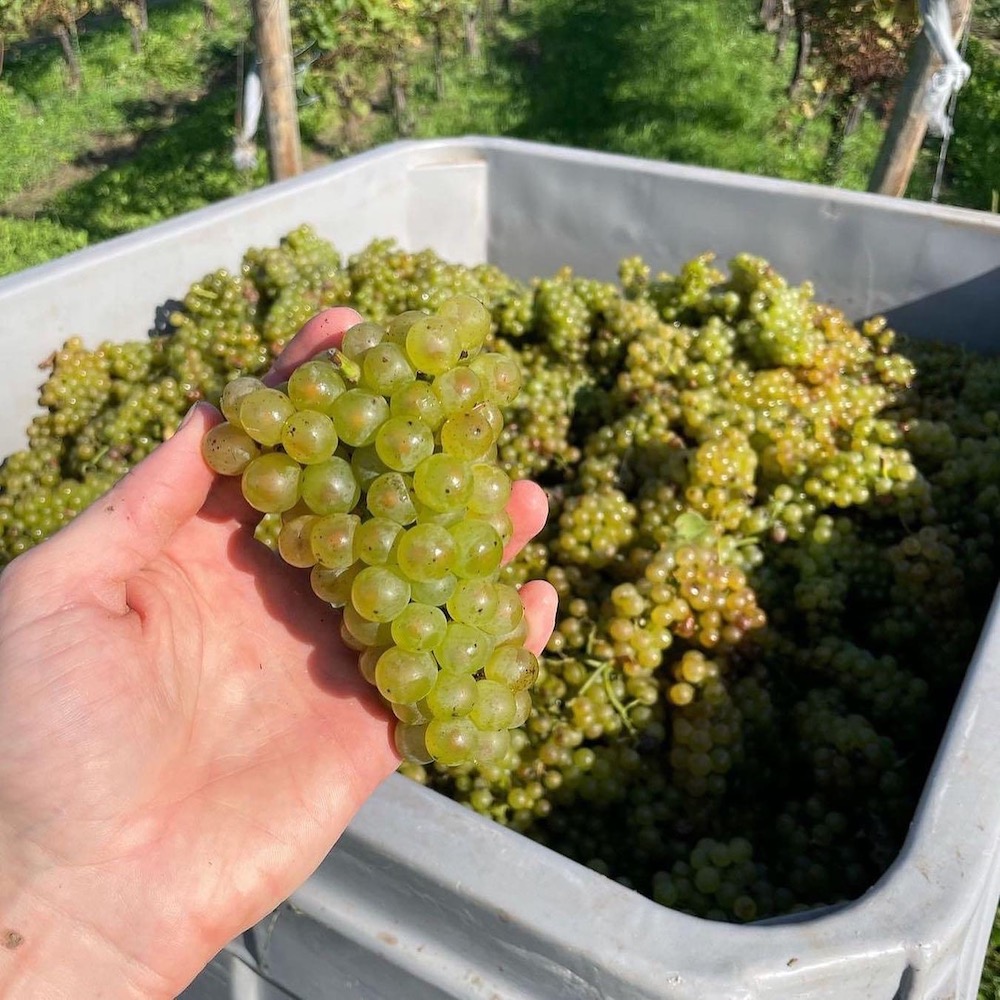



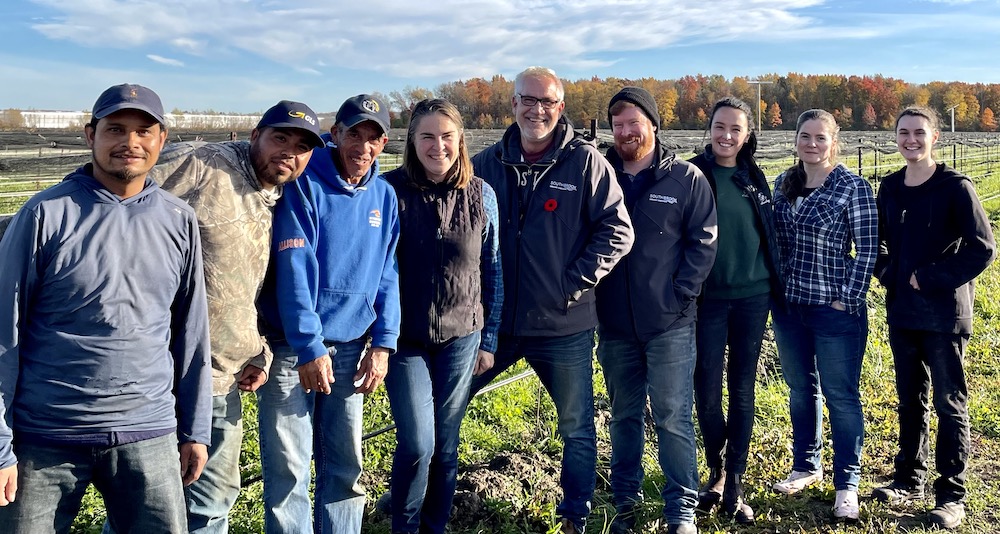

Comment here